PMM





PUT A SPRING IN YOUR STEP: ALL THINGS A /C COVERED INSIDE



INSIDE AN NHS WORKSHOP
YOUR LETTERS ANSWERED
RECRUITING THE NEXT GENERATION
OILS UPDATE
Let’s get technical
INSTALLATION TIPS ON CLUTCHES, SUSPENSION, BELTS & THE TESLA CONTROL ARM
COMMON FAULTS WITH WATER PUMPS & WHEEL BEARINGS


TRAINING FROM DELPHI, LUCAS OIL,VARTA & SCHAEFFLER
SERVICING AND MAINTENANCE TIPS ON THERMALMANAGEMENT, BATTERIES & WHEEL ALIGNMENT




EV FLUIDS & FILTERS
NEW PRODUCTS FROM SEALEY, BARTEC,LASER TOOLS & AUTOGEM

FREE TOTHE TRADE
APRIL 2023
PROFESSIONAL M OTOR M
ECHANIC

Editor’s Picks

12 A MESSAGE TO ELON
Head over to page 12 for a step-by-step guide on how to install Meyle’s replacement control arm intended for Tesla models 3 and Y, brought to you by the aftermarket parts supplier itself.

28 RECRUITMENT ISSUES
In your workshop and in the industry, you might have noticed a problem with recruitment. Simon King from Autotech Recruit discusses issues with retention and job security.

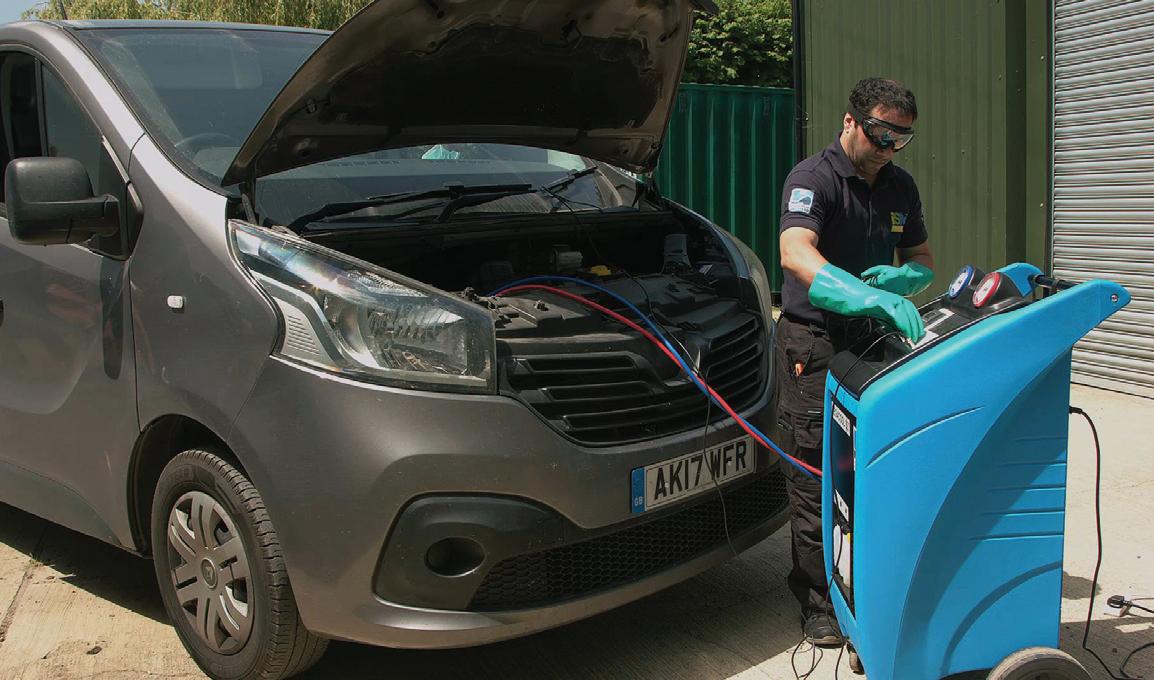
30 EMERGENCY SERVICING

Ever wondered what an NHS workshop is like?
PMM’s Kieran Nee visits one to find out the similarities and differences between the issues they face compared to an independent garage.
48 ‘OIL’ ABOUT EVS
52-55
THE MODERN WORKSHOP
Contents VOLUME 24 ISSUE 4 APRIL 2023 Features Total Average Net Distribution 54,319 1st July 2021 – 30th June 2022 PMM APRIL 2023 3 34-41 A/C & THERMAL MANAGEMENT 42-46 TYRES, WHEELS & ALIGNMENT Regulars 7-10 AFTERMARKET NEWS 12-21 TECH TIPS 22-28 BUSINESS & TRAINING 30-33 SPECIAL REPORTS 57 PIT STOP 58 OUT & ABOUT 61 ONLINE REPORT 62 PRODUCT SPOTLIGHT 63 MYTHBUSTERS 64-65 WHAT’S NEW?
With EVs becoming ever popular, their fluid counterparts will soon become mainstream, and Castrol is expanding its range to cover them. Read inside to find out more. HYBRID&ELECTRIC VEHICLES
48-50
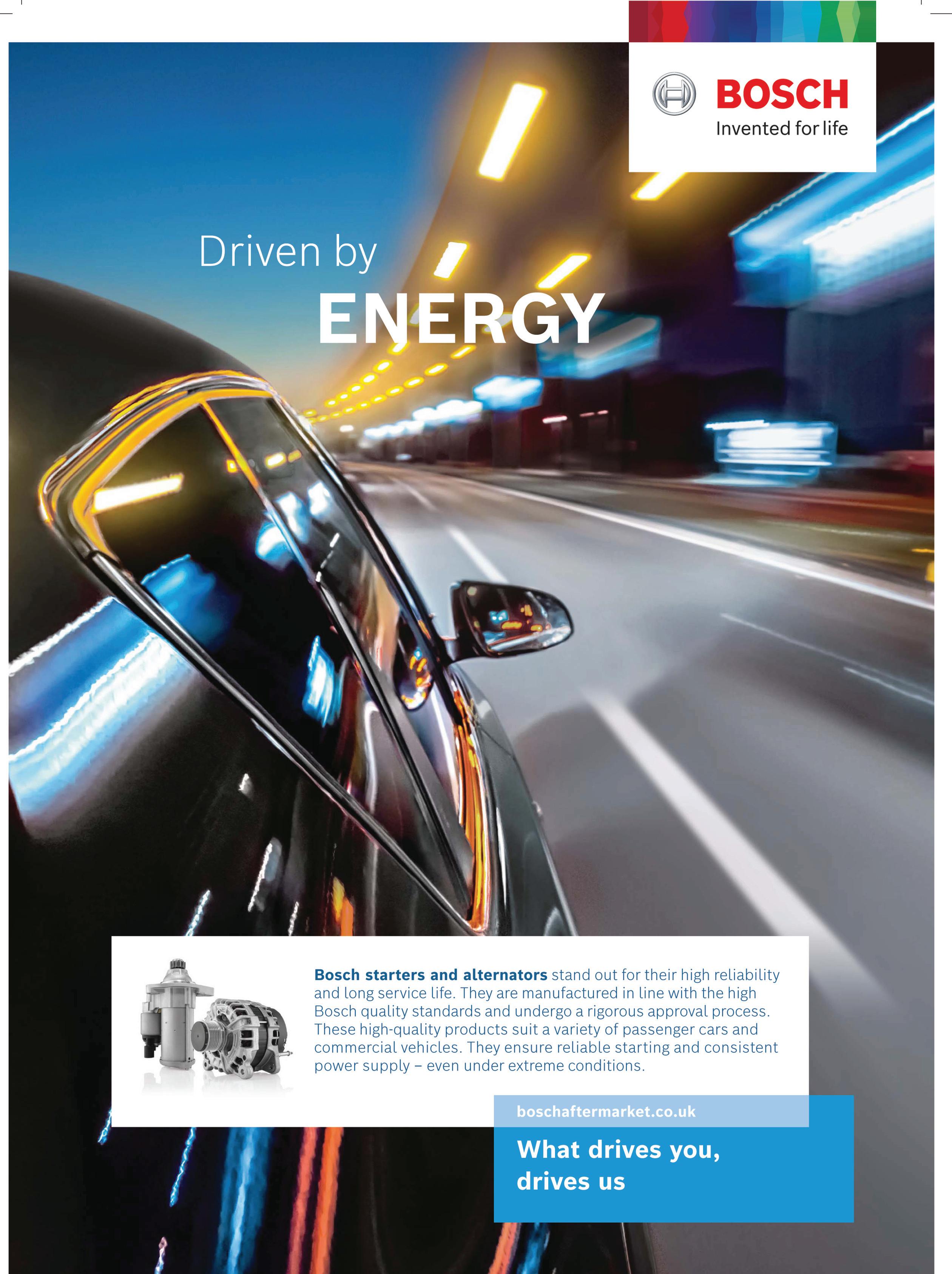 Editor KIERAN NEE
Editor KIERAN NEE

News and Products Editor

FREYA COLEMAN
Digital Manager
KELLY NEWSTEAD
Group Manager
ROBERT GILHAM
Account Manager

ALEX DILLEIGH
Magazine Designer
GEMMA WATSON
Group Production Manager

CAROL PADGETT
Production Assistant
CLAIRE SWENDELL
Distribution Manager
KARL CLARK
Subscriptions
PROFESSIONAL MOTOR MECHANIC is a business magazine for firms and individuals involved in all aspects of the motor trade. It is published eleven times a year and is available nationally FREE to the trade through leading motor factors. It is also available through the post at a cost of £30.
EUROPE and OVERSEAS
1 year (11 issues) £50
Airmail 1 year (11 issues) £65
Printed by Walstead Peterborough
Published by HAMERVILLE MEDIA GROUP Regal House, Regal Way, Watford, Herts, WD24 4YF.


Tel: Watford (01923) 237799
Fax: (01923) 246901
E-mail: pmm@hamerville.co.uk
Sales enquiries: pmmsales@hamerville.co.uk
Website: www.pmmonline.co.uk
Facebook: /ProfessionalMotorMechanic

Twitter: @pmmmagazine
Copyright © 2023
Will anything happen?
Aweek is a long time in politics, they say, and there are a lot of weeks between now and 2030. But if seven years are an eternity in political matters, they can pass in the blink of an eye when it comes to changing both the infrastructure and habits of a country whose mindset is increasingly wedded to a rosier past. Yet, it is this circle which needs to be squared in order for there to be any hope of transitioning away from the internal combustion engine in the allotted timeframe (no new ICE-only vehicles sold by 2030, no hybrids by 2035).
Outside of the trade press, not much thought seems to be given to the logistics and practicality of moving wholesale to electric powertrains. EVs are portrayed mostly as the logical next vehicle for the aspirational middle-class whose environmental consciousness is simply a given. EVs, now that they offer every comfort available, are the perfect display token ensuring everyone else knows that driver has “done their bit” (see also: reusable coffee cups, ‘upcycling’). After all, what is the point of saving the planet if no-one even knows about it? Given this semi-unasked for social status, is it any wonder that half of the media praises EVs to the high heavens, whilst the other half demonise them and their owners as all that is wrong with the modern world (the American ‘woke’ usually worms its way in around here, giving the lie to the journalist’s supposed man-on-the-street cred)?
Refreshingly, asking those in the aftermarket usually turns up a more practical, if fairly uniform, view: Can’t happen, won’t happen – battery-powered vehicles don’t make sense and never will for most people. I will lay my cards on the table here: I am not a petrol fanatic and I do think we all need to make practical life changes to protect the planet, but I am not fully convinced that electric vehicles are the solution and I do struggle to see how the nation’s entire car driving population will switch to EVs. I hope I’m wrong and that in 20 years’ time or so we will all be driving them and, more importantly, charging them without too much extra hassle (well, I actually hope that public transport improves and costs come down so that we don’t need to drive as much, but maybe that’s a little too ‘pie in the sky’).
I won’t go into the reasons for and against EVs here, it’s not my place. Far more knowledgeable people than I discuss this topic daily. The only thing I would like to remind anyone reading this, from either side of the debate, is that EVs are only meant to be a means to an end, with the end being a more environmentally-friendly transport solution. If you are radically opposed to EVs, ask yourself is it the concept of an electrically-driven vehicle which is annoying you or the connotations those vehicles have? If you are fanatically supportive of EVs, be honest: they won’t save you money or save the planet, but they will reduce local emissions. Until each side is honest with themselves, I fail to see anything more than a deadlock come 2030.
Kieran Nee Editor
VIEWPOINT
The publishers and editor do not necessarily agree with the views expressed by contributors,nor do they accept responsibility for any errors of translation in the subject matter in this publication. Listen on Amazon Podcasts Listen on Spotify Podcasts Listen on Apple Podcasts Associate member Find every episode at www.pmmonline.co.uk/podcasts Also available: JOIN M E EACH M ONTH ON THE PMM PODCAST

NEWSIN BRIEF
■ GARAGES ARE MISSING OUT ON APRRENTICES
The IMI warns that automotive businesses are missing out on valuable apprentices that could help bridge the skills gap, despite funding being available through the government’s levy scheme.

■ AUTOMOTIVE SUPPLIER REBRAND
BorgWarner’s aftermarket and fuel systems divisions are to be renamed ‘Phinia’. This news comes as Brady Ericson has been anounced as president and Chris Gropp as vice president to run the spin-off which is expected to be completed in late 2023. The name is said to loosely translate to ‘beauty’ in Gaelic.
■ MOTORSPORT PARTNERSHIP ANOUNCEMENT
MB Motorsport and British touring car championship (BTCC) frontrunner Jake Hill have announced a new title partnership with Laser Tools, that will see Laser Tools Racing with MB Motorsport take to the BTCC grid in 2023.
■ DOUBLE CLUTCH SYSTEM TRAINING COURSES
Schaeffler has announced a series of IMI-approved double clutch system training courses, kicking off in Southam on the 26th and 27th of April.
with Freya Coleman
Call for clarification to draft MVBEO
The Independent Garage Association (IGA) is calling for clarification to the new UK motor vehicle block exemption order (MVBEO), to ensure that consumers are given clear information on their freedom to choose who repairs their vehicles and are not financially disadvantaged by the new regulation.
Stuart James, IGA chief executive, is concerned for “the lack of requirement for in-vehicle messaging to inform customers that they have an alternative solution for servicing via an independent operator. We would also like to see a requirement for authorised repairers to make it clear to consumers that they can chose who services, maintains and repairs their vehicle without invalidating its warranty”
He continues “In addition, the MVBEO makes no reference to a mechanism for
independent operators to access security related information for repairs. Whilst we understand access to such sensitive information needs an element of control, it is vital that there is a recognised system in place for vetted businesses or individuals to provide these services to consumers to ensure fair competition and timley access to vehicle repairs.”
Dangers of working under vehicles
Figures recorded by HSE in the five years up to March 2022 show that 13 workers in the motor vehicle repair industry were killed when work took place under a vehicle that wasn’t properly supported.
Since then, another four have been recorded including Leslie House (pictured) who was working outside his home when he was crushed to death by the Land Rover Freelander he was underneath, which had rolled off the wooden blocks he used to prop it up. He was pronounced dead at the scene by the emergency services.

Official and anecdotal reports of a wide range of working practices gone wrong are leading to fears mechanics and enthusiasts are putting their lives in danger routinely.
HSE’s advice to the trade:
■ Never work beneath a vehicle that is only supported on jacks.
■ Never work beneath a cab or tipping trailer unless it is propped.
■ Never crawl beneath a vehicle fitted with air suspension unless it is properly supported.
PMM APRIL 2023 7
PMM NEWS
PMM NEWS with Freya
NEWSIN NUMBERS
8.5 %
the amount the UK’s used car market declined in 2022 according to figures from the SMMT.
27.1 %
the chance you have of failing your MOT in Kirkcaldy. A-Plan Insurance analysis has revealed this town, situated on the East coast of Scotland, is the area of the UK most likely to fail an MOT.
17
vehicle warranty providers now adhere to The Motor Ombudsman’s longestablished code, designed to keep industry standards in the provision and administration of extended vehicle warranties.
MOT changes
From the 1st of April, the DVSA will change requirements for the calibration of some testing equipment.

This includes decelerometer calibration and the calibration of roller brake testers, plate brake testers and headlamp aim testers.
From April, all decelerometers must be calibrated at intervals not exceeding one year, a change from the previous two year cycle.
Also, calibration of brake testers and headlamp testers will no longer be acceptable if completed by vehicle testing station staff.
Coleman
Level up
Training provider Martec Training plans to boost skillsets for employees within the automotive sector with the launch of a new IMI-accredited apprenticeship route.

This latest level three apprenticeship is targeted towards vehicle damage, mechanical, electrical and trim technicians and will enable those already working in a body shop or garage to further advance their
abilities and knowledge within automotive technology.
As one of the region’s IMI approved centres, this higher-level apprenticeship qualification will be made easily accessible to automotive apprentices throughout the North Staffs area and beyond, delivered from Martec’s Newcastle-based training centre.
8 APRIL 2023 PMM
In pictures: Winners of the CAT Awards including Delphi Technologies for the Delphi Academy for Training Scheme of the Year and Bosch for Supplier of the Year.
FOR UP-TO-DATE NEWS, SIGN UP FOR THE WEEKLY E-NEWSLETTER AT WWW.RDR.UK/AAW040
DATES FORTHE DIARY
■ The BIG Awards are back this year on Friday the 22nd of September at Leicester City Football Club. Categories include the business improvement award, the diversity equality and inclusion award and the training and development award among many others.
EV concerns
The Motor Ombudsman has revealed that issues relating to the purchase process or service received from a business sparked the majority (41 per cent) of consumer complaints about EVs in 2022. This marks an 8 per cent year-on-year increase in the volume of disputes by individuals for these concerns.

For customers who submitted a dispute about the purchase of an EV during 2022, 83 per cent were in conjunction with a new car, with 17 per cent stemming from used
Oil “undervalued”
Nigel Bottom, managing director of Witham Group, gave his verdict on the price of motor oil in the PMM podcast, telling host kieran Nee “I think lubricant has certainly been very undervalued from a raw purchasing point of view”

Bottom explained further, arguing “if you look at climbing a set of stairs, we’ve gone up 10 steps and we’re probably only back down one or maybe one and a half, so by no means are we back to where it was”
He puts the reason for the fluctuating prices down to the war in Ukraine and the
models. In fact, new vehicle delivery delays resulting from supply chain issues and semiconductor chip shortages accounted for over 10 per cent of customer service and purchase-related disputes. Other complaints raised by motorists originated from the use of high-pressure sales techniques, and missing vehicle documentation. Inaccurate information provided to consumers, a lack of communication by sellers, as well as customer orders being cancelled by retailers without notice, equally caused dissatisfaction.
■ PMM has confirmed it will be hosting a stand at this year’s Automechanika Birmingham, which will take place at the NEC in Birmingham on the 6th, 7th and 8th of June. Come and visit our stand for your chance to be featured on the PMM Podcast!
■ Speed of Sight has announced it will be hosting a track dayat Thruxton Circuit in Hampshire to enable disabled people to drive. The event will take place on Monday 4th September 2023 from 10am – 4pm.
■ OPUS IVS is hosting a new trade technical open evening across the19th and 20th of Aprilat the RMI academy in Runcorn. The evenings are free for garages to attend and will run from 6pm to 9pm, with content geared towards training and skills development.
subsequent sanctions of Russian base stock. When asked if he thinks high oil prices are with us for the foreseeable future he responded “Yes. If you gauge the price on where we were 12 months ago.”
To listen, WWW.RDR.LINK/AAW041
PMM APRIL 2023 9
LETTERS Writetotheexperts
A reader got in touch with a query and PMM product tester and diagnostics expert Tony Powell is on the case.
After scratching his head over it, PMM reader Terry Elliot recently got in contact to explain a problem he was facing with his Range Rover P38. The problem was that the remote locking from the key fob wouldn't unlock in the summertime unless he got really close to the rear windows but in the winter, it was working from about six or seven feet away.
We put Terry in contact with diagnostics expert Tony Powell who offered the following response:“From your description of the problem with your Range Rover P38 and primarily the difference between summer and winter, I would suggest if you have done all the basic checks for powers and earth using a test lamp not a meter that you may have a fault on the receiver or transmitter unit. Assuming you keep the transmitter fob in your pocket, the temperature will be mainly constant, so we can rule this out. The temperature could be causing what is termed a ‘dry joint’ to open and close, causing the reception to fail. When you put the fob next to the receiver, it bypasses the requirements for an aerial and works. You would need to find someone who could fix it”
If you have any queries you want to the PMM team to answer, get in touch pmm@hamerville.co.uk
Product finder tool launch
Castrol has launched an online product finder providing directions to workshops that have appropriate products in stock, encouraging workshops to keep themselves well stocked. The new product finder can also be used by technicians prior to carrying out regular service, maintenance and repair work so that they always use the most appropriate fluids.

MOT tester convicted of fraud
An MOT tester has been convicted for carrying out more than 800 fraudulent MOTs. He has been sentenced to eight months in prison on each of 12 counts of fraud, to run concurrently, and suspended for 12 months, 150 hours of unpaid work, 10 rehabilitation days and ordered to pay towards prosecution costs of £2250.
He was also given the maximum ban of five years from MOT testing by the DVSA and will have to re-apply if he wants to test vehicles again.
The offences were committed between the 1st of August 2021 and the 14th of January
2022, during which time he recorded 1300 MOT test, four times more than the usual number carried out in six months. Some of the vehicles being recorded were as far as 279 miles away from the test station and had a decelerometer brake test recorded Marian Kitson, the DVSA’s director of enforcement said “He was both defruading the MOT system and the public who rightly expect the MOT to help keep them and their families safe while using the roads...We will ensure that anyone who compromises safety in persuit of personal gain feels the full force of the law.”

10 APRIL 2023 PMM
MESSAGE ME YOUR NEWS AT FCOLEMAN@HAMERVILLE.CO.UK
In pictures: Engine remanufacturer Ivor Searle’s 10 apprentices, recognising the need to recruit more young people into technical and engineering roles to future-proof the automotive sector.

HOW TO
Install a control arm for Tesla Model 3 and ModelY
Aftermarket parts supplier Meyle provides a useful step-by-step guide to installing its replacement control arm intended for Tesla models 3 and Y.

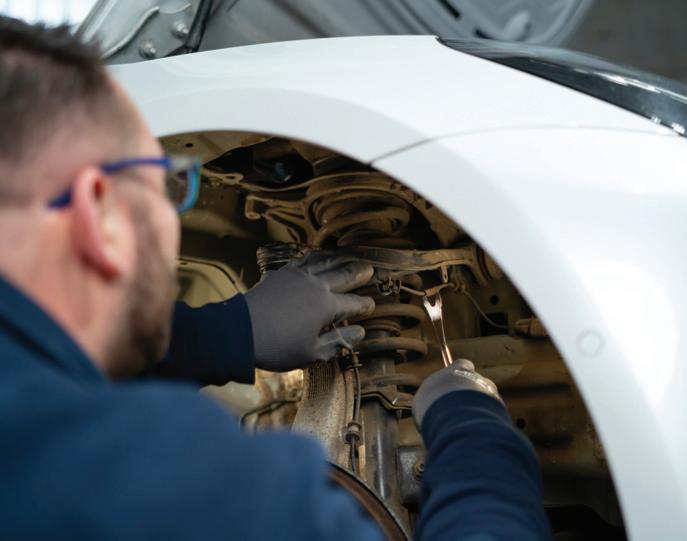



After Tesla drivers all over the world reported annoying squeaking sounds in Model 3 and Model Y series vehicles, Meyle engineers analysed the problem and in January launched the Meyle HD control arm for Tesla models 3 and Y. Meyle claims its aftermarket offering is a technically superior alternative to the original part.
A reminder to all readers of PMM is that a prerequisite to all work on electric vehicles is for the relevant technician to be qualified to work on EVs and have done the appropriate training beforehand.

TECH TIPS
12 APRIL 2023 PMM
“Meyle claims its aftermarket offering is a technically superior alternative to the original part.”
It is advised to change both control arms, with a job time of one hour each side.



STEP
Remove wheel
STEP
Remove inner wheel arch
STEP
Check all the other suspension parts for damages
STEP Release ABS wire
STEP
Remove the frunk
STEP Remove top mount fixings
STEP Remove ball joint and control arm fixings
STEP Pull the control arm out of the top mount
STEP
Push the new MEYLE HD control arm in the top mount
STEP
The adjustment between the control arm and the top mount amounts to 60mm

STEP
Push the ball joint in the swivel bearing
STEP
Tighten all fixings to manufacturer recommended settings:
■ Ball joint screw – 56Nm
■ Bearing control arm – 50Nm
■ Top mount 13mm screw – 35Nm
■ Top mount 15mm screw – 62Nm
STEP
Axle alignment is recommended.

WANT TO KNOW MORE? FOR MORE INFORMATION
WWW.RDR.LINK/AAW001
HOW TO
Replace the clutch on 2014 Iveco Daily
Schaeffler LuK’s Alistair Mason guides PMM readers through a clutch replacement on a 2014 Iveco Daily 35C17 that has covered 56,000 miles and had been recovered with no drive. Diagnosis pinpointed the fault to be the clutch and authorisation was given to replace it.
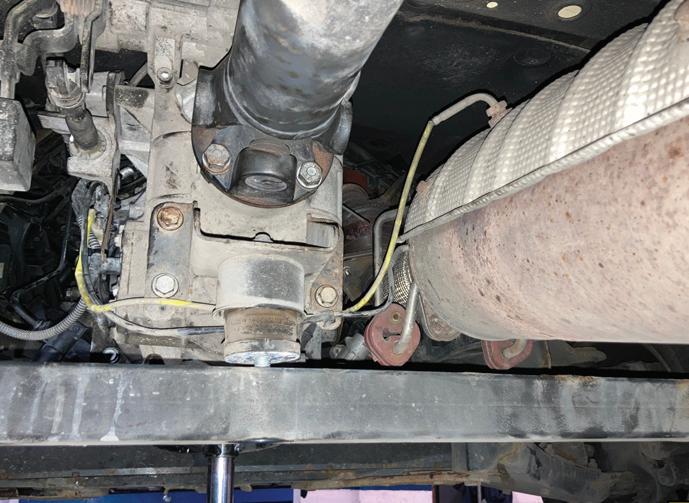

Vehicle Information
Manufacturer: Iveco

Model: Daily 35C17
Year: 2014
Mileage: 56,000
Time: 4.2 Hours
Pull type clutch overview
The advantage of a pull type clutch is that it gives a greater clamp load on the clutch, without an unnecessarily heavy clutch pedal, due to the pivot point/lever ratio of the diaphragm spring being at the outer edge, rather than two thirds or three quarters of the way down the diaphragm spring, and therefore the diaphragm spring must be ‘pulled’ to disengage the clutch. Pull type clutches are generally found in commercial vehicle applications that require the additional clamp load, but can also be found in some of today’s cars. The important thing to know and remember when replacing a pull type clutch, is how the gearbox is removed whilst the release bearing stays attached to the clutch. So, 10 minutes of wisely spent research can save hours of struggling to remove the gearbox!
Gearbox removal
With the vehicle safely positioned on the lift, open the bonnet, disconnect the battery earth lead and stow it safely. This is the only part of the repair that is carried out at ground level, so raise the lift to gain access to the underside, support the gearbox with a transmission jack and then remove the gearbox crossmember by detaching the gearbox mounting nut and crossmember to chassis bolts (Fig.1). With the crossmember
removed, disconnect the prop shaft from the gearbox and unbolt the centre mounting from the chassis (note – it is advised to mark the prop shaft flange and gearbox flange position to eliminate any potential balance issues).

This step gives good access to the electrical multiplugs on the side of the gearbox, so disconnect them, unbolt the bracket and stow away from the gearbox. The gear cables can now be removed (Fig.2) by levering the cable off the ball joints and then easing the outer cables out of their retaining brackets.
Remove the hydraulic slave cylinder by unbolting the metal mounting bracket and stow the cylinder and bracket away from the gearbox. Detach the rubber boot from the release arm (Fig.3), which allows the release arm to pivot far enough around to disengage from the release bearing when the gearbox is being removed.
Ensure the transmission jack is positioned correctly onto the gearbox and, working
CLUTCH
CLINIC
14 APRIL 2023 PMM
around the gearbox, remove the bell housing and starter motor bolts and store them in order of their removal. The gearbox can now be moved away from the engine and at the same time ease the release arm back, so it disengages from the clutch release bearing. Once the gearbox input shaft is clear of the engine and the release arm disengaged, the gearbox can be removed from the vehicle.
Clutch replacement
Remove the six clutch bolts and then the clutch assembly from the flywheel.
In this example, the clutch fault then became evident as, due to ‘slipping’ and overheating, the clutch lining had become detached from the clutch plate and broken up, which had also caused the dual mass flywheel to be exposed to excess heat, this was evident by the blue colour on its surface, affecting the internal springs and grease (Fig.4), (note – it is good practice to clear and vacuum up the broken clutch lining). At this point the customer was contacted and authorisation to also replace the DMF was given.



Turning to the release system in the gearbox, ensure the bell housing is clean and inspect the release bearing guide tube for any wear, and replace it if there is. Check that the pivot point on the release arm is free and also does not have any signs of wear (note –the pivot points are prone to seizing). Apply a light smear of high melting point grease to the guide tube and onto the gearbox input shaft splines and mount the clutch plate, this will confirm it is the correct plate and will also evenly distribute the grease.
Remove the clutch plate and any excess grease,applya light smear of high melting point grease to the pivot points of the release arm/release bearing, fit the new release bearing, engaging it into the release arm as it passes up the guide tube and,when in



position,ensure the releasearmoperates correctly and freely (Fig.5).

Replace the DMF and torque the bolts to the manufacturer’s specification, then clean the DMF clutch face and new clutch pressure plate face using some brake and clutch dust cleaner. Using a clutch alignment tool, mount the new clutch plate onto the flywheel with ‘gearbox side’ facing away from the engine, locate the clutch cover onto the flywheel dowels, insert the six clutch bolts, tighten them in an even and sequential process and finally, torque to the manufacturer’s specification (Fig.6).
A crucial part of this repair is the alignment between the engine and gearbox so that the release bearing locks into the clutch cover on installation. To ensure this alignment is correct, it is critical that the engine to gearbox alignment dowels are installed (Fig.7&8). So, prior to fitting the gearbox, ensure all the alignment dowels are inserted correctly.
Gearbox installation
Using the transmission jack, ease the gearbox into position, confirm the gearbox is located on the alignment dowels and is tight against the engine, then insert the bell housing bolts and tighten them.
The release bearing then needs to be inserted and locked into the clutch by hand. So, pull the release arm backwards, until the release bearing starts to locate into the clutch. At this point, using a lever, ease the arm further back until it snaps into the centre of the clutch, then pull back and forth on the lever to ensure that the bearing is locked into position, then fit the rubber boot. As soon as possible, fit the slave cylinder assembly and operate the pedal to ensure the clutch operation is correct. Once this has been confirmed, the rest of the installation is in reverse order of removal.
After connecting the battery lead, reset all electrical systems as required and always carry out a full road test to ensure a quality repair has been completed.
PMM APRIL 2023 15
WANT TO KNOW MORE? FOR MORE INFORMATION WWW.RDR.LINK/AAW002
EQUIPOTENTIALEVBONDING


Equipotential bonding (EPB) is the process of electrically connecting metalwork and conductive parts, so that the voltage is the same throughout these various parts (an equal potential). EPB is used to reduce the risk of equipment damage and personal injury. It is sometimes simply referred to as bonding and is commonplace in domestic and industrial electrical installations. Its main purpose is safety.
In the near future, all workshops and garages will have to deal with a significant number of high voltage electric vehicles. Checking the safety and reliability of vehicle high-voltage systems is something we will need to become more familiar with.

EVs use an insulated return system so that there is no connection between the highvoltage circuits and the chassis. As part of the start-up process (when the vehicle is switched into ‘Ready’ mode) the on-board insulation monitor device runs a number of tests.
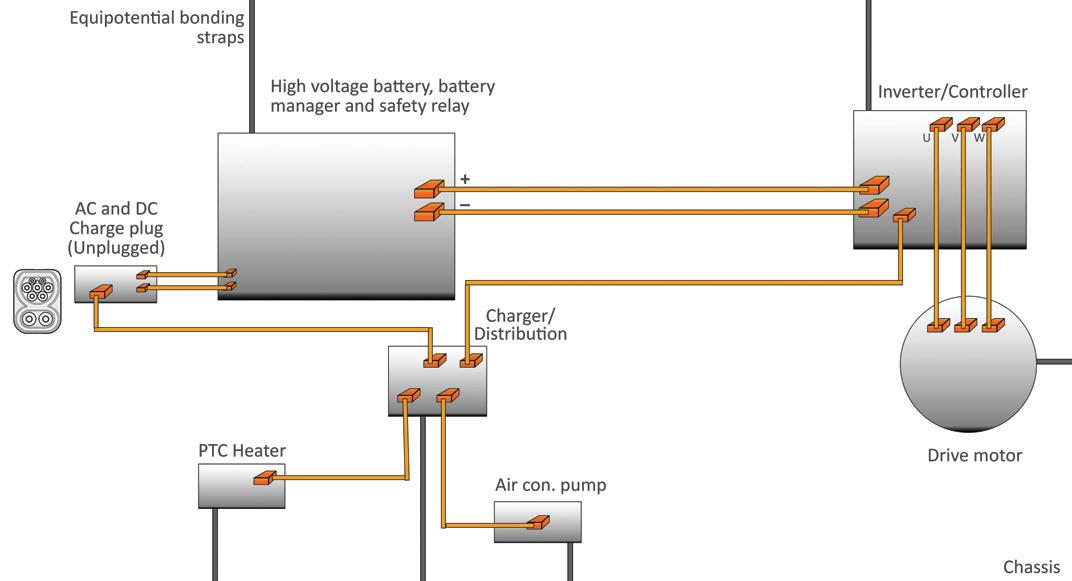
If a failure of this ‘monitor’ is detected, then the vehicle will not






switch on. However, if an insulation fault occurs on a HV component that is not properly bonded, the insulation monitor will not find and monitor this hazardous issue.

The reason that all the components are bonded to the chassis is so that even if insulation faults occur, the potential (voltage) difference between all the main metal components will always be zero – so no electric shock will occur. In theory, this should never happen so the bonding is like a belt and braces approach –better safe than sorry though because the high voltages used can be fatal.


When repairs are carried out the insulation resistance or isolation strength of high-voltage system components is always tested by the technician. The continuity of cables, including the braided shielding is also checked.A value of 500 V is often used for an insulation test but for some systems it is becoming necessary to use 1,000 V. Isolation strength (insulation resistance) of some components can deteriorate over time.
A key part of UN regulation ECE R100 states the specified equipotential bonding between two HV components shall be less than 100 mΩ (a tenth of an ohm). To measure milliohms (mΩ),

special equipment is needed, a normal multimeter is not suitable.
EPB is used to reduce the risk of equipment damage and personal injury from high voltages. Checking EPD can be more involved than it may first appear. However, with the proper equipment, suitable training and time, it is very easy. To date, here in the UK anyway, the equipotential bonding resistance between the components and chassis has not been carried out as a matter of course – other than as a physical ‘hand and eye’ check.

For some organisations, these sort of measurements and records are becoming more important. For individual technicians it is also becoming important to prove all tests have been carried out and so prevent future litigation.

In the next article I will highlight one method of testing EPB and how in the future it could become an income stream for your workshop.
 FIG.2 This bonding strap connects the case of a high voltage component to the chassis on a Golf GTE
FIG.2 This bonding strap connects the case of a high voltage component to the chassis on a Golf GTE
PART ONE Sponsored by WANT TO KNOW MORE? FOR MORE INFORMATION GO TO WWW.RDR.LINK/ AAW003
FIG.1 EV system block diagram showing main components and chassis equipotential bonding
Replacing and installing shock absorbers BEST PRACTICE
KYB offers readers of PMM advice for replacing shock absorbers.

Checking for external failure during an MOT is obviously important, but this fails to consider that shock absorbers naturally wear over time – meaning there aren’t always obvious signs indicating wear or failure. The reason for this lies within the inside of a shock absorber cylinder, which houses a number of carefully calibrated valves. Each valve contains a stack of compression discs (Fig.1), each less than 1mm thick. When a piston rod is compressed, oil is forced through these valves, creating the resistance needed to absorb any bumps in the road. By the time a car reaches 50,000 miles, fluid has passed through these valves over 75 million times. Inevitably, this causes the discs to wear and deteriorate, meaning that fluid passes through more easily, decreasing the damping rate significantly and making the shock absorber much less effective.
To ensure problems don’t slip under the radar, KYB recommends asking your customer if they have noticed any of the following symptoms before checking for external signs:
■ Car pulling to one side.
■ Car unstable when cornering.
■ Vibration in steering wheel.
■ Excessive bouncing over bumps.
■ Nose diving.
■ Veering in side winds.
The importance of priming
Occasionally, a shock absorber will be misdiagnosed as faulty when removed from its packaging for installation. However, the fix is often very simple: priming. Shock absorbers are generally stored and transported horizontally, causing the gas and hydraulic fluid within to mix with one another. Pockets of air begin to form within the oil, affecting the damping force of the shock absorber. Whilst priming is not fundamental to the


operation of shock absorbers, installation without priming can lead to customer complaints about unusual noise or ride harshness as the shock absorbers “break in”. To avoid this, pump the shock absorber 4-5 times in its vertical working position to ensure that the oil and gas move to the correct areas prior to fitting (Fig.2).

Using the right tools
Using incorrect tools risks damaging the shock absorber and can prove costly, with unhappy customers returning for further repairs. There are plenty of tools on the market specifically designed to help – these include:

■ Torque wrenches. It is often considered easier to use an impact wrench to install and remove mounting kits quickly. However, KYB strongly advises against this practice, as using impact wrenches can:
1. Spin the piston rod, causing damage to the valving within the shock absorber. The holes within these valves are lined up in a specific way to allow for fluid movement – if these are misaligned, it can reduce effectiveness of the shock absorber.
2. Cause the bottom nut holding the valving together inside the shock absorber to come loose. Tightened between 7-12Nm in the factory, this nut is prone to loosening when the incorrect tool is used.
3. Sever the thread, leading to complete failure of the shock absorber (Fig.3).
Instead, use a torque wrench and tighten to the manufacturer’s torque recommendation after the full weight of the car has been applied.
■ Strut Nut Kit: When completing the above, don’t place gripping pliers on the piston rod when tightening the upper nut. This can score the highly polished chrome shaft, increasing wear on the upper seal, in turn causing a hydraulic fluid leak. Instead, using a strut nut kit will allow you to hold the piston rod securely without damaging the shock absorber (Fig.4&4a).
If you don’t have a kit, most shock absorbers have an area where it is safe to hold onto the piston rod using a spanner, located near the top of the shaft, just above where the thread starts. Or for some, there’s an indent for a hex key at the top.
WANT TO KNOW MORE? FOR MORE INFORMATION
PMM APRIL 2023 17 TECH TIPS
WWW.RDR.LINK/AAW004
a b
HOW TO
Replace the timing belt on a 2007-16 Renault Kangoo II
This month’s Belt Focus comes from Dayco. The timing belt is being replaced on a 2007-16 Renault Kangoo II, fitted with a 1.6 litre petrol engine (K4m.8.30)



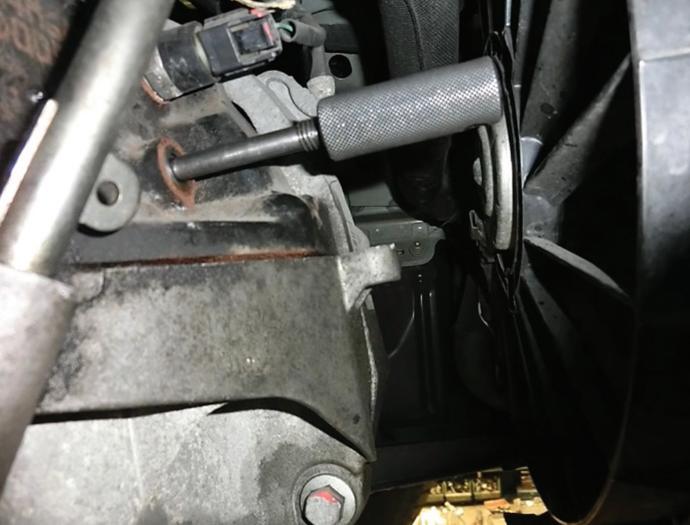
The popular Renault Kangoo, also badged as the Nissan Kubistar, has been in production since 1997, with a second generation introduced in 2007, the petrol version of which, until superseded in 2016, used a 1.6litre engine that featured a timing belt-driven water pump. As replacing the belt also requires the auxiliary drive system to be removed, Dayco recommends that all the systems’ components – primary and auxiliary drive – be replaced at the same time.
This step-by-step technical guide will help technicians through the process, to avoid complications and ensure a first-rate job.
As with all primary drive system jobs, the work should be undertaken when the engine is cold, so ideally the vehicle will not have been run for at least four hours.
After disconnecting the battery earth cable and draining the coolant, remove the windscreen wiper arms, then the bonnet seal on the plastic bulkhead, the two trims either side of the windscreen, the cover set in the bulkhead and finally, the bulkhead itself. This reveals a cross-piece and, underneath, the wiper motor and linkages that both now need to be removed, along with the dividing plate, followed by the airbox.
Vehicle Information
Manufacturer: Renault
Model: Kangoo
Year: 2007-16
Engine: 1.6 petrol (K4m.8.30)
After removing the front offside wheel, detach the inner cowling and its reinforcement mounted in front of the crankshaft pulley. With access to the auxiliary drive system, use a spanner on the tensioner to take the tension off the belt so it, and then the tensioner, can be taken off. Now remove the lower tie rod attached to the powertrain.
Returning to the top of the engine, remove the two plastic plugs covering the camshafts, mounted at the opposite end to the timing drive system. Then remove the plug in the engine block behind the cooling
fan and insert the crankshaft timing pin (Tool 1489) (Fig.1), rotating the crankshaft clockwise with the pulley bolt, until the pin locates. The camshaft timing tool (1496/1750) can now be fitted where the plugs were removed.
Support the engine underneath with a suitable jack and remove the right-hand upper engine mount (Fig.2) followed by the engine mounting flange that also acts as the upper timing belt case. Next, detach the crankshaft pulley. As this holds in place the crankshaft pinion, which has no locking tab, the engine must be timed first. Then remove the lower timing belt case.
Holding the camshaft pulleys in place, loosen their fasteners (Fig.3), but again, as these also have no locking tabs, loosen them only after the engine has been timed. Then remove the belt tensioner, idler and the timing belt, which gives access to the water pump, and can now be removed.
18 APRIL 2022 PMM
BELT FOCUS
“As replacing the belt also requires the auxiliary drive system to be removed, Dayco recommends that all the systems’ components – primary and auxiliary drive – be replaced at the same time.”
Ensuring that the cooling system has been flushed through and no debris is present, fit the belt tensioner stud into the new water pump from Dayco kit KTBWP4601 (Fig.4), tighten it to 5 Nm (-0+2) and then install the pump with its gasket. Although none should be used on the gasket, the threads of the bolts that secure the water pump do need to be spread with sealant. Attach the new belt tensioner ensuring that the locking tab is located in the slot in the water pump body (Fig.5). Remove the crankshaft pinion, clean its inner section and the exposed shaft, but do not lubricate these contact surfaces. Likewise, do not lubricate the surfaces between the camshaft pulleys and their shafts.
Install the timing belt and then the idler, but leave the slack section facing the belt tensioner. Tighten the idler fastener to 50 Nm. Using an hex key, rotate the tensioner so that the index is aligned with the centre of the reference mark (Fig.6) and tighten the fastener to 30 Nm. Then tighten the fasteners on the camshaft pulleys to 30 Nm + 85°. Refit the lower timing belt cover and then after checking that the crankshaft is correctly



resting against the timing pin previously inserted into the engine block, position the crankshaft pulley and tighten the new fastener from the Dayco kit to 40 Nm + 145°. Remove the crankshaft timing pin and camshaft timing tool and, using the crankshaft pulley bolt, rotate the engine clockwise several times and then retime the system properly re-using the special tools. Through the lower window of the lower timing belt cover, check that the index and the reference mark on the belt tensioner are correctly aligned (Fig.7). If necessary, turn the tensioner through the window to
reposition it correctly.
Once the engine has been timed correctly, refit the timing tool plug in the engine block and insert the plastic plugs covering the camshafts on the cylinder head by applying sealant to their edges.


Refit all the components in their reverse order, but check, and if necessary, replace the crankshaft pulley with Dayco DPV1260 and the auxiliary belt tensioner with Dayco APV3180. However, Dayco recommends the auxiliary belt 6PK1200 is always replaced. For vehicles manufactured after 2013, check the auxiliary belt requirement, as some versions use 6PK1130.
Finally, refill the cooling system, start the engine and carefully check for leaks and ensure the radiator fan operates at the correct temperature, replace the thermostat Dayco DT1091H if necessary. Then, once the engine is cold, check the level of the fluid again.
PMM APRIL 2022 19
WWW.RDR.LINK/AAW005
WANT TO KNOW MORE? FOR MORE INFORMATION
COMMON FAULTS
Water pump issues
Febi explores some common water pump faults across a range of makes and models.
MODELS
Various Audi, SEAT, Škoda and Volkswagen models with 1.6 & 2.0 TDi engines.
FAULT
The engine is overheating, the coolant temperature gauge reads over 110°C and the interior heater is performing poorly. Additionally, cooling system fault codes may be logged in the engine control unit (ECU)
CAUSE
The water pump fitted to these vehicles has an ECU-controlled collar, which interrupts the coolant flow to make the engine more thermally-efficient. However, the control collar can seize, or the plastic impeller can break-up or come away from the shaft.
SOLUTION
Ensure the engine is cool, then remove the coolant-filler cap. Remove the small pipe to the coolant header tank and hold this over the filler neck of the header tank. There should be a small trickle of coolant flowing with the engine at idle, and this should increase in flow upon increasing the engine speed. If the flow rate does not increase, this would suggest a faulty water pump.
Replace the defective water pump with febi 180948, which features an improved control-collar design; this has been thoroughly tested to eliminate the potential failure of the original water pump. The solenoid valve must be removed from the old original pump and fitted to the new pump, including new seals, which are provided in the kit.
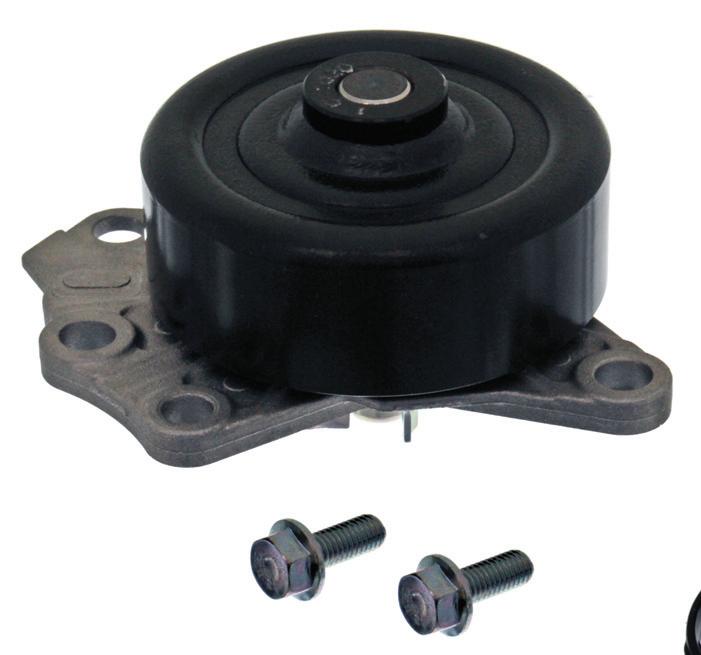

Fill the cooling system with the correct coolant, then vacuumbleed the cooling system. Finally, carry out the cooling system bleeding procedure using a suitable serial-diagnostic tool to expel all the air from the cooling system.
MODELS
FAULT
The water pump leaks.
CAUSE
The water pump fitted by the vehicle manufacturer can leak, because the material used is perforated steel sheet. In the worst case, this can lead to significant engine damage.
SOLUTION
febi recommends using water pump no. 32682. This modified version of the water pump is manufactured from aluminium die casting. This makes the pump significantly stronger and prevents leakage. Additionally, febi supplies water pump 32682 including the required gasket and suitable bolt set.
Fitting Tip: When fitting the new version (32682), use the bolts supplied with water pump. Torque setting for bolts is 28nM. The vehicle manufacturer’s specifications should always be followed. Both old and new versions are still available in the aftermarket; however the new version does not contain the required bolts.
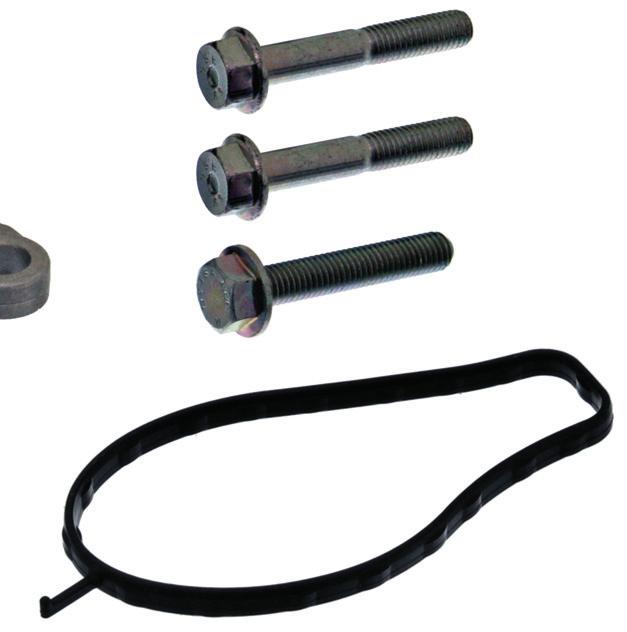
TECH TIPS 20 APRIL 2023 PMM
Citroen C1 1.0, Daihatsu Cuore VII 1.0/Sirion 1.0, Peugeot 107 1.0, Subaru Justy 1.0, Toyota Aygo 1.0/Yaris 1.0
MODELS
Various Volkswagen, Audi, Seat and Skoda models fitted with the 1.4 litre TDi engine.
FAULT
Engine overheating, coolant temperature gauge reading over 110° C and poor interior heater performance. Also cooling system fault codes maybe logged in the engine control unit.
CAUSE
The water pump fitted to these vehicles has an ECU controlled collar, which interrupts the coolant flow to make the engine more thermally efficient. However, the control collar can become seized, or the plastic impeller can break up or come away from the shaft.
SOLUTION
Ensure the engine is cool, then remove the coolant filler cap. Remove the small pipe to the coolant header tank and hold this over the filler neck of the header tank, there should be a small trickle of coolant flowing with the engine at idle. This should increase in flow when the engine speed is increased. If the flow rate does not increase, this would suggest a faulty water pump.
Replace the defective water pump with febi 108778, this is a conventional water pump, which eliminates the potential failure caused by the control collar. The solenoid valve must be removed from the old pump and fitted to the new pump. This is so the engine management system can recognise it. Failure to replace the solenoid valve will log an engine management fault.


Fill the cooling system with the correct coolant, then vacuum bleed the cooling system. Finally carry out the cooling system bleeding procedure, using a suitable serial diagnostic tool, to expel all the air from the cooling system.
MODELS
Audi, Seat, Skoda, Volkswagen - Various models 1.6 & 2.0 TDi engines
FAULT
Engine overheating, coolant temperature gauge reading over 110° C and poor interior heater performance. Also cooling system fault codes maybe logged in the engine control unit
CAUSE
The water pump fitted to these vehicles has an ECU controlled collar, which interrupts the coolant flow to make the engine more thermally efficient. However, the control collar can become seized, or the plastic impeller can break up or come away from the shaft.
SOLUTION
Ensure the engine is cool, then remove the coolant filler cap. Remove the small pipe to the coolant header tank and hold this over the filler neck of the header tank, there should be a small trickle of coolant flowing with the engine at idle. This should increase in flow when the engine speed is increased. If the flow rate does not increase, this would suggest a faulty water pump.

Replace the defective water pump with febi 103078, this is a conventional water pump, which eliminates the potential failure caused by the control collar. The solenoid valve must be removed from the old pump and fitted to the new pump. This is so the engine management system can recognise it. Failure to replace the solenoid valve will log an engine management fault.
Fill the cooling system with the correct coolant, then vacuum bleed the cooling system. Finally carry out the cooling system bleeding procedure, using a suitable serial diagnostic tool, to expel all the air from the cooling system.
WANT TO KNOW MORE? FOR
MORE INFORMATION
PMM APRIL 2023 21
WWW.RDR.LINK/AAW006
TRAINED UP
battery e-learning course.
The Varta team has announced a new suite of battery e-learning courses which are now live on its partner portal which will complement the company’s more traditional face-to-face-training. The various courses will complete the digital knowledge portfolio, following the company’s YouTubechannel’s educational playlists, technical articles in the Battery World, Battery Finder and other social media platforms.




User experience

The company’s goal is to provide the best user experience during its training – both online and offline. “Our E-Learning offerings are aimed at everyone who deals with batteries in their daily business”, says Ulrich Germann, training and technical support manager at the training academy.
“We want technicians and sales advisors, wholesalers and retailers to be able to understand the new technologies and today’s
complex vehicles. We want to share our profound knowledge in a user-centric approach so that our customers can be successful in their daily business.” They continue.

Keeping up with modern technology
The first technological advancements around the battery came with the introduction of start-stop systems. Since then, fuel-saving functions go far beyond simply switching off the engine at traffic lights; many standard features are not even noticeable by the driver. For workshops to be able to repair these complex systems in the future, the training modules will continually update to ensure technicians are prepared. In addition to general topics such as “warehousing and storage” or the “Varta brand and USPs”, there is also more indepth technical material such as “vibration resistance” or “deep cycling capabilities”. The next technological leap is already underway, as the role of the traditional 12 V battery is more important than ever for hybrid and even pure electric vehicles.
BUSINESS & TRAINING
22 APRIL 2023 PMM
Expanding the range
After the launch, a new series on the topic of drivetrain electrification and the role of the 12 V battery in electric vehicles is already in development. Varta e-learning courses are currently available within its partner portal. Registered users get access to a complete offering of digital training on:


■ basic battery knowledge
■ advanced passenger cars
■ heavy commercial vehicles
Simply login and click the ‘menu’ in the top left of the screen, then you have free and unlimited access to the Varta portal.
“We are very pleased to be able to support the UK and Irish aftermarkets with these free-toaccess e-learning courses and hope that technicians and factor staff find them useful and informative.” says John Rawlins, marketing manager. “Our intention is to provide bitesize online training to complement the face-to-face training we already provide; we don’t intend to stop that”.

WANT TO KNOW MORE? FOR MORE INFORMATION WWW.RDR.LINK/AAW007
“Our intention is to provide bitesize online training to complement the face-to-face training we already provide.”
Reasonsto TRAIN yourteam
We saw an uptick of interest in our training services during the Covid lockdowns. The disruption left lots of garage owners and technicians with extra time, leading to exploration of our diagnostics solutions, training and skills development. Since then, garages have maintained interest – within an industry changing very fast. Autonomous driving technologies, electrification of the vehicle parc and different diagnostic processes are amongst the key step-changes independents face. Cars are changing, the drivetrains, the onboard technology and the methods of interacting with the vehicle are all transforming.

Yet with new car sales stalled and motorists holding on to vehicles longer, many independents are seeing brisk business.
More and more garages are looking to adopt structured training and development programmes to maximise these opportunities. Even doing some of the simplest service jobs now require access to the vehicle’s ECU and coding capability so new skills, new equipment and a commitment to continual learning are absolutely essential.
Training centre
We’ve focused on future technology within our Warwick training centre, with vehicles, service equipment and test rigs for technicians to work on – there’s still no substitute for ‘hands on’ learning.
The growth of the Delphi Technologies Academy, launched in 2021, has been rapid with around 1,200 users gaining flexible access to over 300 courses and modules, all of which have been compiled by in-house trainers.
The academy gives a convenient way to enhance skills and knowledge without the challenges of attending physical training. There’s a Training Needs Assessment which includes a series of questionnaires and online ‘practicals’ before suggesting modules to complete tailored to that user. Hybrid and electric vehicle training is the perfect example of the benefits of a true blended learning experience.
For the more advanced EV course we provide six hours of online pre-learning on electrical systems to try and get the foundation knowledge of electrical principle to then build upon in the training centre.
Online can also be great for reinforcement or showing specific things that can’t easily be staged in the training centre; for the technicians there’s also the benefit of being able to learn at their own pace.
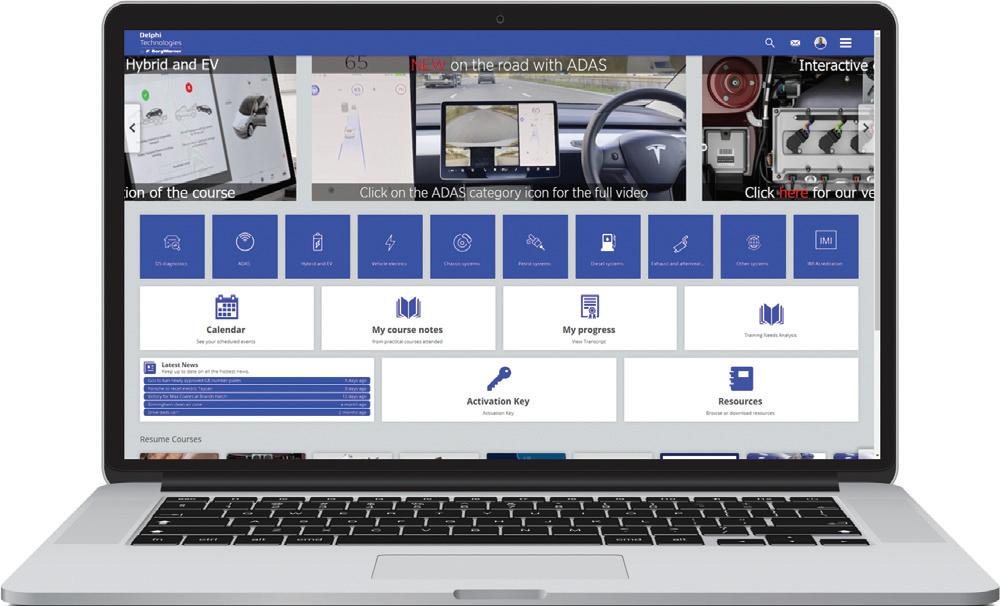
CPD pathways
We at Delphi are at the forefront of delivering structured training with “more than 70 per cent” of delegates following a defined training pathway, mapped to industry-recognised IMI qualifications. Available paths include IMI Fast Fit, Service/Diagnostic and Master Technician assessments. The first two are Level 2 qualifications, with Diagnostic Technician being a Level 3 and Master Tech a Level 4.
Each of the pathways provides between four and seven modules which are one or two days in duration. IMI Accreditation is then dependent upon completing an additional assessment day afterwards. Each online

BUSINESS & TRAINING
24 APRIL 2023 PMM
Delphi Technologies’ technical services manager Luke Garratt, discusses how UK technicians could be gaining CPD points for their training.
module is also IMI Continuing Professional Development (CPD) accredited. Videos typically include an easily digested overview, concluding with a quiz to test learning.

An Advanced Lighting Technologies course, for example, takes just 25 minutes to complete, introducing the various types of lighting used on current vehicles including LED and laser lights.
New technologies
We’ve focused our training around emerging new technologies. This means autonomous Advanced Driver Assist Systems – or ADAS – systems such as adaptive cruise control, emergency braking and adaptive headlights as well as, of course, vehicle electrification. Training on this technology is absolutely vital for safety first and foremost, after that, garages need confidence and technical competence to start working profitably.
Four of the five most popular training courses relate to EVs and hybrids. The latest figures from the SMMT show why. 2022 saw registration of electric vehicles surge at the expense of petrol and especially diesel.
Diesel registration fell 38.9 per cent compared to the previous year. On the flip side of the coin, battery EV registrations rose over 40 per cent to 267,000. In fact, total hybrid and EV sales exceeded petrol and diesel engine vehicles combined, with a 52.6 per cent share.
Our Hybrid and Electric Vehicle Level 3 course enables a technician to disable and power up high voltage system safely to change components. Beyond this, there’s a two day Level 4 course which covers diagnostics. With the power off, fault finding can be difficult so this course goes much more deeply into diagnosing live high voltage systems including high voltage battery repairs from different manufacturers.
The UK aftermarket has been talking about hybrid and EVs as a future opportunity for years but over the last 18 months we’ve seen a shift with many more garages looking to get involved now. This urgency is due to the looming 2030 deadline, dire warnings from policymakers over unpreparedness for our EV future and the baseline business case rising numbers of EV vehicles presents.
Value for money
Garages have to make tough calls on how to allocate their resources. We’re finding staff retention is a key driver for training these days. Recruiting skilled technicians is difficult and expensive so a modest ongoing investment in training over several years can pay for itself in making it easier to attract new technicians. Staff retention is boosted too because technicians who feel they are developing their abilities won’t be as easily tempted to move for a few pounds more in their pay packet.
It’s a big ambition but we want to offer the complete training solution. That means covering lots of scenarios and technologies within a flexible blended framework that provides a clear progression route for the technicians and business owners involved. WANT

PMM APRIL 2023 25
TO KNOW MORE? FOR MORE INFORMATION
WWW.RDR.LINK/AAW008
“Four of the five most popular training courses relate to EVs and hybrids. The latest figures from the SMMT show why.”
PMM THE PODCAST



WHAT DO CHANGING A BATTERY, CHANGING A BABY (JUST THE NAPPY) AND CHANGING YOUR MORNING RADIO STATION ALL HAVE IN COMMON?
THEY OFFER THE PERFECT OPPORTUNITY TO LISTEN TO THE PROFESSIONAL MOTOR MECHANIC PODCAST WITH KIERAN NEE.



HEAR ADVICE ON PRICING JOBS, MANAGING PARTS SUPPLY, ELECTRIFICATION, RECRUITMENT AND MUCH MORE.





Listen on Google Podcasts Listen on Apple Podcasts Listen on Amazon Podcasts Listen on Spotify Podcasts LISTEN NOW ON YOUR PODCAST PLATFORM OF CHOICE
New mechanic TRAINING
In a new series of technical seminars, the UK’s next generation of professional motor mechanics is learning how additive technology is being used to reduce vehicle emissions and to support garage service and maintenance routines. They are also learning the value of informing customers about the continuous maintenance dividends that automotive additives can deliver.

The Lucas Oil Academy, which is the training arm of US brand Lucas Oil Products, works closely with technical colleges. It’s been using shows such as Mechanex, Race Retro and local trade events to demonstrate and promote additive benefits for student mechanics.
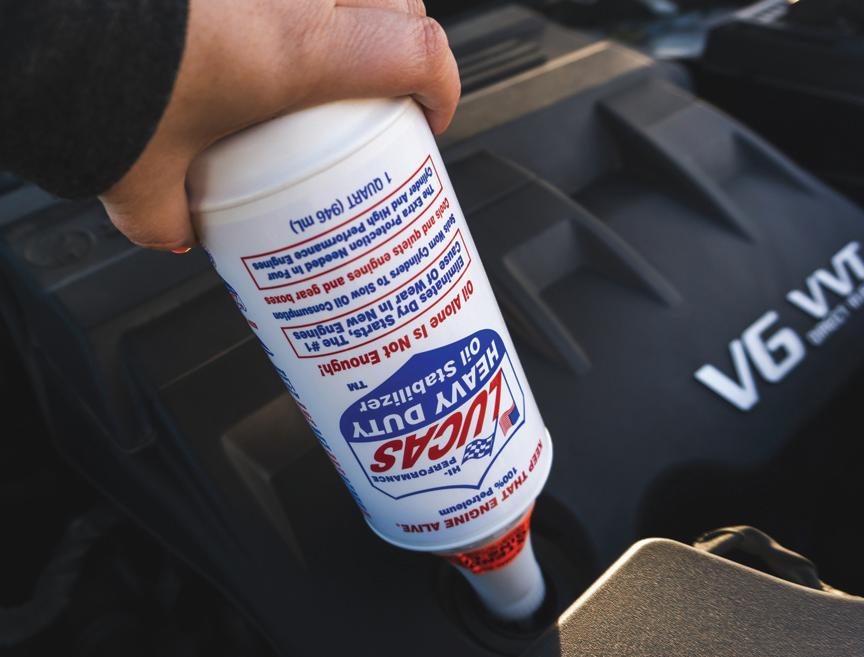
“For example, we explain that because
our Heavy Duty Oil Stabiliser provides a coating to all internal engine components, it is perfect for cars with oil-fed timing chain tensioners,” says Lucas Oil Academy technician Nathan Owen. “Good examples of the kind of models that particularly benefit are found among certain cars in the Vauxhall range, often associated with engine noise and rattling. Our LOA students learn why this kind of product is ideal for tired or worn engines. It’s because it raises oil pressure. It adds lubricity. It lowers oil temperature. It helps to extend the operational life of the oil. That’s a quality that’s especially useful for car owners who are often tardy about bringing their vehicles in for a service.”
Students of the LOA learn how to apply additive technology more appropriately. They
return to their local garages more able to offer a range of alternative solutions that can benefit both garages and their customers.
“For customers struggling with the cost of living crisis, additives that can reduce emissions or extend component life offer solutions that are more affordable. For garages, additive sales provide not just solutions but add preventive maintenance options that will increase garage efficiency and put numbers on to the bottom line,” adds Nathan Owen.
PMM APRIL 2023 27
BUSINESS & TRAINING
TO KNOW MORE? FOR MORE INFORMATION
WANT
WWW.RDR.LINK/AAW009
Lucas Oil discusses its new training academy and what it can offer aspiring technicians.
Want secure FLEXIBILITY?
For the automotive industry, retention has been a problem for some time and attracting the right talent is an ongoing issue. We are starting to see salaries rise, particularly for vehicle technicians, and, whilst this does put additional pressure on employers, it is incredibly positive and long overdue. As the saying goes, money talks, but people, especially those with sought after skills, recognise their worth and the industry needs to keep up with new technology, while exploring all potential avenues, to ensure they attract and keep hold of the right people.
Last year was a candidate’s market and 2023 is likely to follow suit. People are seeking a greater level of flexibility and employment on their own terms. If they don’t get it in their current job, they are very likely to look elsewhere, and retention rates have become a real problem for most organisations.
The structure of the UK workforce is changing profoundly. Flexibility is the key driver of this change, and 65 per cent of businesses surveyed revealed they understood the need to play the ‘flexibility game’ to attract the right people as it opens them up to a much wider pool of talent. But flexibility isn’t a one size fits all solution, and of course, for the automotive industry, working from home really isn’t an option. It may be choosing the hours they work and when they work to strike a better work life balance. We have contractors working for us who prefer seasonal work so they can spend time indulging their hobbies or working on their other side businesses.
People want greater choice today. It’s why there are now over 4.2 million self-employed workers in the UK.
The freelance revolution

Sparked by the financial crisis and the unemployment that followed, freelancing became one of the biggest trends of the 2010s. At the time, it was a necessity for many but, when the pandemic hit, it became a choice. People had a taste of hybrid working
and they wanted more of it. For employers, 64 per cent say that using contractors helps them to address the skills gap, while enabling them to turn the tap on and off as needed when it comes to specialist support.
This sentiment fits the automotive industry exactly, and it’s one we have been beating the drum about for over a decade. Using temporary vehicle technicians and MOT testers to cover resource gaps, whether brought on by sick leave, holiday or a lack of available talent, is a solution automotive bosses are tapping into time and again. These contractors are in charge of their own destiny, they know that training and being skilled in the latest automotive technology will help them remain agile and employable.
It’s widely known that the automotive industry is fishing for talent in a rapidly depleting pool. While there are initiatives in place to upskill existing workers and harness a new generation, we also need to look at those who left the sector and lure them back in.
Technicians who, faced with the evolution of vehicles, opted to retire early rather than upskill, are now starting to return to working and flexibility is key.
Job security
While contracting is undeniably on the rise, for many, job security can be a real deal breaker. With mortgages to pay and mouths to feed, particularly during the cost of living crisis, taking the plunge to become a contractor can be daunting and bring a host of concerns. When we started the business back in 2010, it was a contractor revolution. Freelancing within the automotive industry was relatively unheard of, today while our network continues to grow, demand is outstripping supply and the contracts are becoming more long term. Any fears of not having enough work are unfounded. But to appeal to more people and reach out to those who left the sector in a bid to entice them back, we are offering full-time permanent employment, with all the benefits that entails, and the variety of work that comes with being a freelancer.
WANT TO KNOW MORE? FOR MORE INFORMATION WWW.RDR.LINK/AAW010 BUSINESS & TRAINING
Here, Simon King, managing director of Autotech Recruit discusses the challenges the automotive industry is facing when recruiting.
28 APRIL 2023 PMM
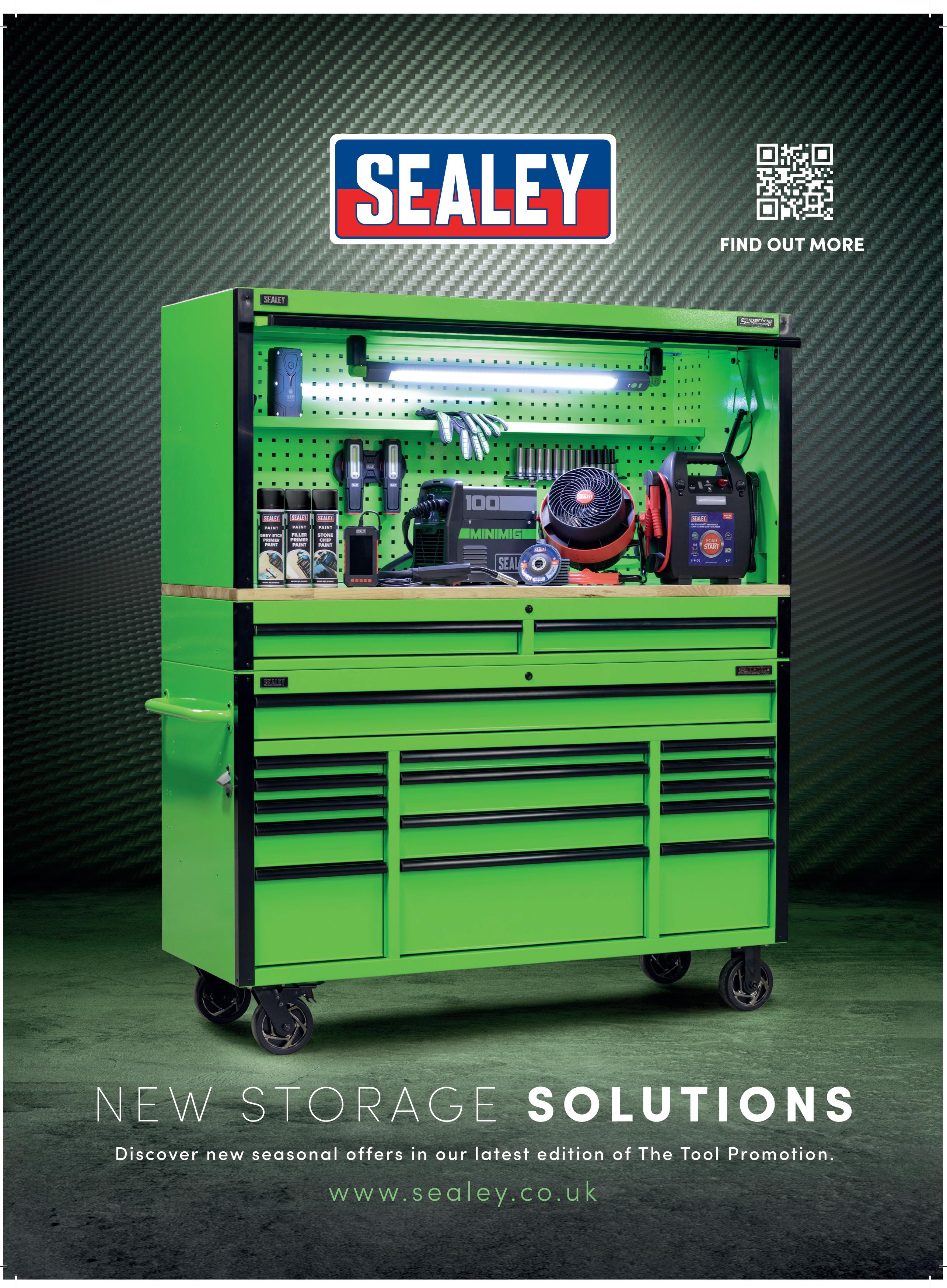
Technicianson the FRONT LINE
PMM’s editor Kieran Nee went to Banstead to visit Ross Crook, an area workshop manager for the Southeast Coast Ambulance Service to find out what particular challenges an NHS workshop faces and discovers that there is more in common with an independent garage than he had first thought.


It was at our annual Mechanex trade show, last year, that Ross Crook and John Giles, area workshop managers for the NHS’ Southeast Coast Ambulance Service first approached the PMM team to ask if there was any way we could help. Not being the handiest of people (editors rarely are), we asked how we could possibly be of any use to someone in charge not just of repairing vehicles but repairing actual life-saving ambulances. I like to think my editorial viewpoints are somewhat interesting and maybe raise the odd smile, but they’re hardly emergency services-level useful.
And then came the familiar lament, one we’ve grown so used to hearing in recent years it’s almost becoming a cliché: “We

can’t get any staff, it’s becoming a real problem”. So I went to the service’s Make Ready Centre in Banstead, one of the 12 workshops that Ross and John oversee, covering over 600 vehicles, 398 of which are ambulances, to find out more about what is involved in repairing vehicles for the NHS.
Each workshop has between four and six technicians on site, working seven days a week, 52 weeks a year, including early and late shifts. Besides the routine maintenance, there is a lot of un-planned repairs to do, so the workshops needs to be able to react quickly and ensure the fleet is back on the road as quickly as possible.
One advantage, Ross explains, over an independent workshop is that they know what vehicles are coming up for servicing and
when – it’s all planned well in advance. But it’s not just the ability to pre-plan which will be whetting the appetite of the put upon independent technician: “As much as possible, a lot of the work we do is not just planned, but also preventative maintenance. So a lot of the guidelines that we work to are above and beyond what the manufacturer or the general road user might use. For example, we might have our brakes all replaced at 50 per cent. Our tyres are all replaced at 3-4mm, depending on the vehicle model.” In short, the NHS vehicles are treated similarly to any other piece of equipment it uses to care for people and everything practicable is done to eliminate the risk of nasty surprises.


SPECIAL REPORT
30 APRIL 2023 PMM
There is a flipside to this prudence. As the more fiscally concerned of our readers might already be getting their letter stationary ready, it’s worth pointing out that Ross’ crew are subject to the same cost restrictions as the rest of the civil service: “Ae also have to get the balance right financially, because we need to consider that we are an outfit that's spending money and that we need to make sure that we're getting value for money for our users and for our trust and for the wider public.”
As might be imagined, sourcing parts at a moment’s notice isn’t quite as simple as going down to the local factor and certain “online marketplaces” are certainly out of the question: “We have a lot of frameworks that we need to work within. Some of our suppliers are set up through certain frameworks, so that makes it slightly challenging in getting parts at times because of the framework. The sheer complexity of our vehicles as well. We've got the equipment to look at.”
Let’s take a look at some of that extra equipment: “Some have got ramps and winches in order to bring stretchers onto the vehicle. We’ve got a tower lift assembly. Then you’ve got your systems which are integrated into the vehicle itself – the blue lights, of course, extra ECUs that control things in the back. We've got additional heating and cooling, we've got additional braking. So, for example, this vehicle we've got here today has got an electromagnetic brake underneath to improve the braking system.” And that’s not even going into the medical and patient care equipment on board.
The nature of the driving – quick, across terrains, high mileage (“upwards of 1,000 miles a week”) – and the extra weight means parts such as brakes and suspension wear out rather more quickly than normal. But such an accelerated service schedule has unexpected consequences, as Ross explains: “Because we are doing so many miles and because we have such a number of vehicles, we probably see faults even before the manufacturer sees them. Data’s a massive thing for us, and I think actually it’s quite underutilised in an independent environment. If you can look at some of your metrics, even in its most basic form, you can try and understand your business a little bit better to discover which
areas you can improve on and what challenges you face – it may allow you to step out of the situation and have a conversation with your parts supplier or something.”
Skills shortage
Beyond the advanced technological solutions put to use by the service to ensure a steady balance of jobs throughout the year, it is a distinctly human problem which Ross is struggling to solve: getting people through the door in the first place. “I’ve kept an eye across the board and it seems we’re just facing the same problems as the rest of the industry –there really is a national skill shortage and it is something that’s really hitting us hard. I think it’s definitely getting worse. When I’m driving around visiting site to site, I notice there are a lot more vacancy bulletins out there.”
When I ask Ross what he thinks may be the reason for the shortage, he turns to the increasing complexity of modern vehicles: “We’ve got to remember there are lots of things on vehicles which are continually updating. For us in particular, a lot of people don’t know that ambulance and blue light service maintenance for vehicles in some areas is done in-house.”


WANT TO KNOW MORE? FOR MORE INFORMATION
WWW.RDR.LINK/AAW011
PMM APRIL 2023 31
OILS under the spotlight
Amidst an ongoing war in Ukraine and disruptions to global supply chains, prices of oil remain uncertain. Couple this backdrop with a cost-of-living crisis at home and, the VLS is warning workshops, we could be seeing a wave a counterfeit oil on these shores.
Rising costs are putting immense pressure on workshops and motorists alike to save money where they can. As a result, the industry trade body, the Verification of Lubricant Specifications (VLS), is expecting a rise in counterfeit lubricants as criminals look to cash in and sell cheaper alternatives to genuine products.
“Counterfeiting affects many vehicle parts and accessories, and lubricants are no exception,” according to chairman Mike Bewsey. “Modern vehicle engines are highly complex. They require sophisticated lubricants using advanced chemistry, backed by the investment of millions of pounds, dollars or euros by major additive companies. These additive companies use extensive bench, laboratory or real-life engine testing to guarantee performance standards and safety.
Although the vast majority of lubricants on the market are genuine, types of counterfeit oils might include:
■ Virgin base oil with a sub-standard additive pack or lower spec base oil being used
■ Virgin base oil with no additive pack at all
■ Used oil that has been repackaged and presented as new oil
■ Re-refined product that is unsuitable for its stated application
■ A lesser-spec oil presented as a premium specification
Compared to standard formulations, counterfeit products might have fewer or even no additives at all. This can significantly affect the lubricant, resulting in poor or possibly even dangerous performance compared to genuine products. Just like using the wrong oil, using counterfeit oil could lead to accelerated wear in gears and bearings, the formation of lacquers on surfaces such as pistons and the development of sludge that could restrict oil flow. All of which could lead to increased maintenance costs and, if left unchecked, eventual engine failure.”
Cash-strapped motorists may also try to buy oil themselves to save money. With limited knowledge in such a technical area, they risk buying counterfeit oil online or from other unscrupulous sources, which isn’t what it purports to be.
Too good to be true?
VLS is urging workshop owners, mechanics, technicians and end users alike to take a series of common-sense steps to reduce the risk of buying and using a counterfeit product:
Purchase lubricants from reputable sources such as official distributors or wellregarded motor factors. Avoid purchasing finished lubricants from unofficial sources or less reputable internet sites where the source of the product is unclear. Avoid products that appear to be heavily discounted or are being sold in a hurry, such as ‘fire sales’ or ‘stock must go’ end-of-line promotions.
Check for authentic marks on packaging, such as batch codes. Most reputable
lubricant blenders use batch codes as part of their ISO quality assurance processes. If a product does not have a batch code or authentic serial number, there is a greater risk that it might not be genuine.
If a lubricant manufacturer is claiming ACEA specifications, check to ensure that they are a signatory to the European Engine Lubricants Quality Management System Letter of conformance for lubricant manufacturers

(https://www.sail-europe.eu/ registrations/lubricant-marketers)
Check any packaging and product labels carefully. Fraudsters will aim to maximise revenue at minimum cost, so they may use lower-quality packaging or labelling. Does the packaging look and feel of appropriate quality and as you would normally expect? Looking at the product label, is the spelling and use of grammar correct? Is the colour on the label an exact match against previously purchased authentic products or are the colours slightly washed out? Are the text and images clearly printed or a bit blurred and not as sharp and well-defined as they could be?
Is the pack integrity supported by a tamper-evident seal that is evident?
Ask for Technical and Safety Data Sheets. Reputable suppliers should have no problem producing these or advising you where to access them. Suppliers trying to pass off counterfeit lubricants may be evasive about providing this important information.
Taking these simple steps can ensure counterfeit products don’t cause unnecessary breakdowns or damage your reputation.
WANT TO KNOW MORE? FOR MORE INFORMATION WWW.RDR.LINK/AAW012 SPECIAL REPORT
32 APRIL 2023 PMM
LIGHTS, camera, ACTION!
PMM is looking for the next star for its YouTube channel.

Do you work in an independent workshop? Are you an experienced technician with plenty of knowledge to share? Do you want to raise the profile of your workshop and be at the forefront of new industry developments? If you have answered yes to all of the above, then we have the perfect opportunity for you and your workshop. We are looking for the best technicians in the country to join the PMM team at the forefront of the independent aftermarket. We care about educating and informing our sector and we know you do too! We want your help to make our media output the best it can be.
IF YOU’RE INTERESTED, EMAIL KIERAN NEE AT PMM@HAMERVILLE.CO.UK WE CAN’T WAIT TO HEAR FROM YOU!
 This is an opportunity for technicians and MOT testers of all ages and from anywhere in the UK to get their hands on the latest tools and products, get in front of the camera and provide cutting edge product reviews for the PMM YouTube channel.
This is an opportunity for technicians and MOT testers of all ages and from anywhere in the UK to get their hands on the latest tools and products, get in front of the camera and provide cutting edge product reviews for the PMM YouTube channel.
KNOW YOUR PARTS
Thermal management system
Febi explores what technological changes are occurring within the thermal management system and gives advice to workshops on maintaining these systems.

For many decades, 99.9 per cent of internal combustion engines have relied upon water (coolant) being pumped around the engine block and cylinder head to prevent overheating and thermal distortion, caused by heat of the combustion process. As the coolant is pumped through the engine casing it absorbs heat. It then circulates through a radiator to be cooled, before returning to the casing again for the cycle to be repeated. The heating/cooling process is controlled by a thermostat to maintain a constant temperature.
The water pump, like many other auxiliary components (e.g. PAS pump, alternator and A/C compressor), has traditionally been driven mechanically off of the engine crankshaft (or camshaft) via a belt. The trouble with this method is power is continually sapped from the engine which negatively affects vehicle performance and fuel economy/emissions.
Vehicle manufacturers have been developing alternative ways to drive and control these components to improve efficiency and economy, with many vehicles now fitted with electric power steering, and more beginning to use electric air conditioning compressors.
Electronically controlled and powered water pumps were introduced by BMW back in 2004. These have several advantages over the engine-driven pumps being used previously, as the electric water pump is totally controllable under all conditions. The advantages include:
Completely variable speed – the pump can run at any speed depending on what the ECU requests.
■ It can provide a low flow rate when the engine is cold to allow a faster warm-up.
■ It can provide a faster flow rate to cool a hot engine quickly.
The pump can run without the engine.
■ This allows the engine to cool evenly, reducing ‘hot spots’ in the engine
■ Especially useful for vehicles equipped with stop-start or on hybrid vehicles.
These advantages mean greater efficiency and help to reduce a vehicle’s emissions.
Another major advantage is that an electric pump can be positioned almost anywhere within the engine bay, allowing much greater flexibility and better use of space. The water inlet can be positioned on the side of the engine for cross-flow cooling which helps avoid ‘hot spots’ and provides more efficient cooling across all cylinders (Fig.1).
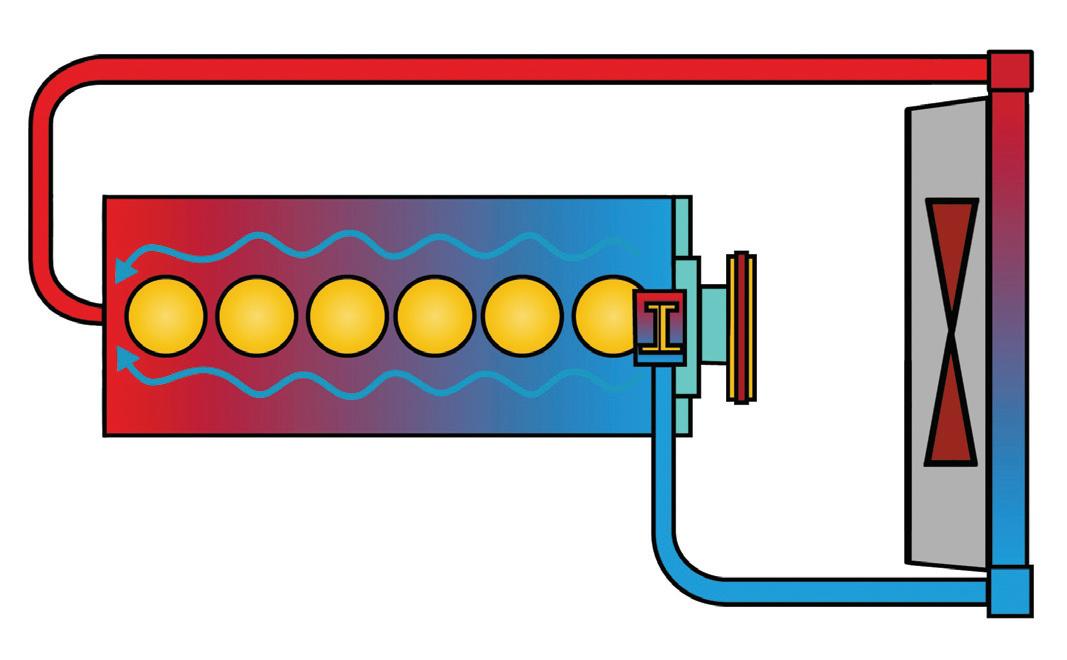

This is not possible with a belt driven water pump as it has to be positioned at one end of the engine, meaning the coolant is always circulated from one end to the other, resulting in some cylinders running hotter than others (Fig.2).
Intelligent water pump
The electric water pump is controlled by the engine management. It can determine the necessary cooling requirements by watching engine load, operating mode and the data
A/C & THERMAL MANAGEMENT 34 APRIL 2023 PMM
FIGURE
Basic function of an electronic water pump: The cylinder being evenly cooled.
FIGURE
Basic function of a belt-driven water pump: The cylinders are not uniformly cooled, some can run hot.
Cooling diagram
from the temperature sensors. With this information it can determine the correct coolant pump operation and speed, and send the corresponding instruction to the pump’s control unit.
The electric pump also has selfdiagnosing capabilities to aid with fault finding, with fault codes and live data available to read via the vehicle’s serial diagnostic port using a suitable tool. Data for speed, current and temperature can be found in the serial data to assist with diagnosis, as well as a function to actuate the pump to check whether it’s operating correctly.
Codes for incorrect pump speed, excessive temperature, over and under voltage, system blockage, coolant loss and air in the system are examples of the codes that can be generated.
The pump has a four wire connector: power, earth, Local Area Network (LAN) communication, and control from the engine management using pulse width modulation (PWM). The output of the wet-rotor brushless electric motor is controlled electronically by the electronic module, which is located under a cover in the water pump unit.


Maintenance tip
Care must be taken when carrying out maintenance (such as a coolant change) to ensure that the pump does not run dry. If the pump is removed and it is intended to be reused, it should be stored filled with coolant. If stored empty the pump could seize which would lead to overheating and potential engine damage. If the pump should ever become dry, the pump impeller should be turned by hand before connecting the coolant hoses to ensure it hasn’t seized. The system should then be immediately filled with coolant. Care should be taken during assembly to ensure that the electrical connector is clean and dry and that the connections are undamaged. When replacing or refitting the water pump the aluminium fixing bolts must be replaced and correctly tightened to the vehicle manufacturer’s specification.
When refilling the cooling system after replacing the water pump, it is essential that the cooling system is bled of air. First, vent the air via the bleed screws on the cooling system until bubble-free coolant can be seen, and then close the bleed screws. Close the coolant expansion tank cap, and then carry out the following procedure.
■ Connect a battery support unit to the vehicle’s battery.
■ Switch on the vehicle’s ignition.
■ Set the heater to maximum temperature and turn heater fan down to its lowest speed.
■ Fully depress the accelerator pedal for 10 seconds. The engine must not be started.
■ The electric water pump is activated when
the accelerator pedal is pressed which indicates the air bleeding procedure has started. It takes approximately 12 minutes during which time the engine should not be started.
■ Once the procedure is completed the water pump will automatically stop.
■ Top up the coolant in the expansion tank to 100ml above max.
■ Check the cooling system for leaks. If the system needs to be re-bled (e.g. if the cooling system is leaking), allow the engine management system to completely shut down by turning the ignition off and removing the ignition key for approx. 3 minutes. Then repeat the procedure.
PMM APRIL 2023 35
WANT TO KNOW MORE? FOR TECHNICAL ARTICLES FROM FEBI WWW.RDR.LINK/AAW013
FIGURE
The coolant in the system flows through the motor of the coolant pump, cooling both the motor and the electronic module, as well as lubricating the bearings
“If stored empty the pump could seize which would lead to overheating and potential engine damage.”
BEST PRACTICE
A/C servicing
Hofmann Megaplan gives readers of PMM its top tips for air conditioning servicing.

Most people associate air conditioning with the summer and focus on its ability to reduce the interior temperature of a car on sweltering days, but that’s not the only benefit of a properly maintained A/C system.
Cool air is not the only thing generated by A/C, it also produces relatively dry air, with most of the moisture removed; exactly what drivers need during the colder months as it demists the insides of the windows incredibly quickly – dry air absorbs the moisture straight off the inside of the glass.
Over time, the refrigerant in the A/C system can seep out of the seals and moisture can build up inside the system too. Running the system on low levels of refrigerant doesn’t only mean you won’t get the designed temperature drop in the vehicle. More importantly, for car or van owners, the A/C pump will be continually running, trying to generate the necessary pressure, which will
then put extra strain on the components leading to premature replacement. It could also increase fuel consumption.
Moisture build-up inside the air con system can corrode the internals, degrade the performance and lead to failures; an A/C system needs maintaining just like any other part of a vehicle.
There are two main types of refrigerant used in vehicles today, R134a and the newer R1234yf. R134a is extremely harmful to the environment and has a significant impact on Global warming, hence the change to R1234yf. The newer gas began appearing around 2013 but uptake was sporadic so the older gas is still in a lot of vehicles today. An A/C service entails connecting the ‘recharge’ equipment to the vehicle to recover the existing refrigerant into the equipment’s internal tank. On its way to the tank, it is thoroughly cleaned using complex filters and separators to ensure all the impurities and moisture is taken out. Any oil recovered is disposed of into the A/C machine’s catch tank.
Once the system is empty, the equipment generates a vacuum inside the refrigerant circuit, holding it in this this vacuum state for around 20 minutes, so that any moisture in the system evaporates (boiling point reduced due to pressure change) and is drawn out of the system and expelled through the A/C machine. After that, the equipment carries out a leak test by closing the system and watching for any pressure drops. If any oil was recovered, it is replaced with new oil and vehicle’s A/C circuit is filled with fresh refrigerant (most of what goes back into the vehicle is the original refrigerant, just thoroughly cleaned).

Top tips:
■ It’s always worth checking the drive belt for the A/C pump, just in case it needs replacing.
■ Looking after your refrigerant is key to cost control. When you fill the equipment with new refrigerant, make sure you note how much has gone in (and when) and ensure the virgin gas is returned to a secure area.
■ A/C refrigerant is expensive. Remember to keep an eye on the amount of refrigerant being used to highlight any issues with working practices that may be costing you refrigerant.
■ Don’t attempt to fill a system that has a leak, not only is it illegal to knowingly release refrigerant into the atmosphere, it’s also expensive. If you see the refrigerant leaking out, you will have lost a considerable amount before you manage to recover what’s left in the system.
A/C & THERMAL MANAGEMENT 36 APRIL 2023 PMM
Megacool 320 Aircon Recharge Unit
Manufactured in Italy, the megacool 320, from Hofmann Megaplan is a fully automatic vehicle air-conditioning recovery system, suitable for light and heavy commercial vehicles, and available in R134a and R1234yf


gas. It’s a perfect option for the garage owner who recognises the value in having a totally automatic machine, requiring minimal manual input from technicians, whose time can be used elsewhere in the workshop. The features include: Automatic oil; dye injection; an integral printer and Bluetooth connectivity, for use with a remote tablet or PC.
Advanced features include easy operation via a user-friendly control panel with a largeicon graphic display; and automatic ‘minimal intervention’ working cycle – the machine has no manual taps which require a technician to operate them; high precision oil and dye injection thanks to a load cell based weighing mechanism; a ‘full recovery function’, which performs multiple checks and additional recovery cycles to ensure maximum gas recovery from the A/C system; a flushing system, which purges the machine of oil, so it can be used on hybrid or electric vehicles, or vice-versa; accurate air-purge thanks to dual
pressure gauges, which enable accurate release of non-condensable gasses for optimum efficiency; Aircon Diagnostic/Pressure test –dual temperature sensors facilitate a fast and accurate diagnostic performance test of the A/C system.
WANT TO KNOW MORE? FOR MORE INFORMATION
WWW.RDR.LINK/AAW14

Playit COOL
Technicians are at the frontline when it comes to air conditioning and climate control systems and as service and repair of these areas is far from simple and requires specialist knowledge, they need to have the right partner when it comes to the parts they need, as well as the technical advice to allow them to tackle the work with confidence and do the job right, first time.
As more hybrid and electric vehicles take to the roads, more will come into the workshop for routine climate system maintenance or repair. However, the technicians undertaking this work need to be aware that they require special handling and safety procedures, as well as a deeper level of specialist knowledge to complete it successfully.

Heat pump solution

Using the thermal system as an example, many EVs rely on a heat pump solution, whichis an advanced system compared to a standard A/C loop, so adds further complications.
As a result, the first thing on the wish list
for independents in a busy workshop is access to reliable technical support. Nissens openly shares its expertise on the A/C system’s maintenance, troubleshooting and component installation. Its technical insights cover new technology trends and include the latest thermal management systems. This technical support is accessible in various forms, from online assets to live training.
Also on the list are replacement components of premium quality that ensure easy installation. Every component in the A/C range is manufactured to ‘Genuine Nissens Quality’. This standard is benchmarked to match the same level as the original equipment part quality, aiming to provide optimal performance and durability. In addition, all of the A/C system’s critical importance parts are designed as a ‘First Fit’ replacement, which means all the necessary parts are included in the product box so that technicians can undertake an easy, safe, and proper first-time-right installation.
Next on the wish list are components that, provided they are fitted correctly, last. Many
of Nissens’ products incorporate features that prolong the lifespan of each component and claim to deliver years of value to vehicle owners. All the company’s condensers are corrosion protected, for example, and by applying this specially designed coating, it is able to produce a replacement with a longer lifespan than would normally be possible.




The Nissens climate system programme is designed to enhance the competitiveness of the independent workshop and enable it to be fully prepared to serve its customers during the busy A/C season.
The complete range comprises more than 3,600 part numbers and offers high car parc coverage, including 450 A/C parts for hybrid and EV. This range is constantly expanding and grew by 150 last year alone, and of these components are 40 A/C system pressure sensors that cover 160 OE part numbers and high-voltage A/C compressors for Tesla Model 3, Kia Niro, Hyundai Ioniq and others.
A/C & THERMAL MANAGEMENT
WANT TO KNOW MORE? FOR MORE INFORMATION WWW.RDR.LINK/AAW015 38 APRIL 2023 PMM
Nissens outlines what it offers to technicians performing A/C servicing.


KEEPING COOL
For many car owners, air conditioning is now thought of as an essential function. Not only does it make driving far more comfortable in our hot summers it also proves valuable in demisting windows during the frosty winter months. Tool specialists Sealey outlines its offering in maintaining air conditioning systems.

To keep the air conditioning system operating at its optimal capacity, it is vital that regular checks are carried out, particularly if the system hasn’t been used for a while. Failing to maintain the system effectively can be costly both in terms of system repairs and potential ill-affects to the driver’s health.
It is recommended that a car’s air conditioning is serviced every 12 months to two years. It’s important to make customers aware that air conditioning systems will lose performance over time. Whether the air conditioning is used a lot or hardly at all, aircon gas will continue to permeate through the system. Therefore, carrying out a service at least every two years will keep the gas topped up, and the system lubricated, so the driver will always have a cool blast ready.
The company also offers many valuable service tools for leak detection within the air conditioning system. The VSAC135 pressure test connector kit is designed to suit a wide variety of vehicle air conditioning systems. The kit allows systems to be pressured for the purposes of leak testing prior to repair and re-gassing.


The VSAC002 air conditioning system features a two-way manifold and sight glass for monitoring refrigerant flow. The two gauges are marked for both R134A and R12 pressure readings. The unit is easy to operate, with colour coding on the gauges, valves and hoses.

When refrigerant gas is lost from the air-con system, a car’s fuel consumption increases. With less gas to use in the air-con system, the car’s engine must work harder to keep the system functioning properly. Eventually, when the system has lost enough gas, drivers will notice the air-con does not expel cold air anymore. Mould build-up in the vehicle’s evaporator is another common issue that can occur with an unused or unmaintained air conditioning system. The evaporator is a key component in the air conditioning loop and allows freezing refrigerant to pass through it. The cold air coming off the evaporator is then blown into the vehicle cabin when the air conditioning is activated. If the driver has noticed an unpleasant odour, then mould in the air-con could be the cause. Sealey’s SCS023 air conditioning refresher eliminates odours from aircon and heating systems, leaving the system clean and free of germs.
UV leak detection is a quick, easy and low-cost method for discovering leaks of all sizes and can also be used to highlight invisible leaks, such as air-con gas. To trace the leaks, an appropriate UV fluorescent fluid is added to the system and is then run or pressurised so that fluid will emerge from whatever leaks may be present. Illuminating the area with a UV lamp, such as the Sealey LED3604UV or LED220UV, can quickly reveal all the leaks as they will glow brightly where the UV light meets the fluorescent additive.
PMM APRIL 2023 41
A/C & THERMAL MANAGEMENT
WANT TO KNOW MORE? FOR MORE INFORMATION WWW.RDR.LINK/AAW016
BEST PRACTICE
Air suspension maintenance and repair
Air suspension specialists Arnott explains the influence of air suspension during wheel alignment.
When discussing wheel alignment, technicians are referring to the adjustment of the vehicle’s suspension to align the angles of the tires according to the manufacturer’s specifications. Tyre misalignment can be the result of hitting a curbstone too hard, driving through a large pothole at high speed, or a collision, and also after repair or replacement of steering and suspension components. Since air suspension is a part of the vehicle suspension, it can influence the wheel alignment process after a replacement or repair. Not all air suspension components influence wheel alignment.
Components that take care of the air distribution such as the compressor, valve block, pressure reservoir, and air lines do not interfere with the vehicle’s camber, toe, and caster. Air struts however, do play an important role since they are part of the suspension that connects the wheels to the vehicle.

Impact
Arnott recommends always checking the wheel alignment after an air strut replacement. Wheel alignment is mostly affected by the front suspension. Rear alignment is usually not necessary when replacing rear air struts, shocks and/or air springs. In most cases the rear suspension has fixed mounting points which cannot be adjusted and therefore replacements do not influence the vehicle alignment. It should be noted, however, that when a front air strut is replaced and has been removed from the clevis, the alignment is affected, especially when a control arm was detached as well.
TYRES & WHEEL ALIGNMENT 42 APRIL 2023 PMM
“If the vehicle is not completely levelled, wheel alignment is nearly impossible because the base line is incorrect.”
Difference with coil spring systems

One major difference between wheel alignment of coil suspension systems and air suspension systems is that a ride height calibration is necessary before starting the wheel alignment procedure. The height sensors need to be calibrated to the predetermined ride heights to ensure that the vehicle is 100 per cent level and according to manufacturer’s specifications before starting the actual wheel alignment procedure.
Height calibration is vehicle modelspecific, meaning the values can vary slightly between models and also within the same model. Always follow the manufacturer’s instructions on how to calibrate the vehicle and what the predetermined heights and values should be. If the vehicle is not completely levelled, wheel alignment is nearly impossible because the base line is incorrect. When the car is not levelled, the control arms of the vehicle’s suspension are in a different position and angle. Since air suspension has the capability of changing the ride height of the vehicle, wheel alignment based on an unlevelled car can really be exposed by changing ride height.
Luckily, with most alignment equipment, the height calibration for air suspension is incorporated into the procedure. If selected, it will most likely ask if the vehicle has been calibrated. The alignment criteria/values for a vehicle with air suspension will differ from its model without. Therefore, it is important to make sure the right criteria for the vehicle that is being worked on is selected by using the value spectrum indicated by the alignment equipment that matches the air suspension vehicle. That is why calibration is key for air suspension vehicles before starting the wheel alignment procedure.

PMM APRIL 2023 43 WANT TO KNOW MORE? FOR MORE INFORMATION WWW.RDR.LINK/AAW017
RANGE LIFE
Drive more slowly and smoothly
Electric cars are notoriously faster off the line than their petrol or diesel equivalents, but it is wise to limit full throttle accelerations to not only stay safe on winter roads, but also to extend your EV’s range. Where possible, keep your speed under 60 mph; as speeds increase, drag and rolling resistance increases too. Utilise your car’s “Eco” mode, if it has one.
Use EV-specific tyres
Electric cars can perform with a suitable standard tyre – they don’t have to be EV-specific tyres. However, if you are keen to maximise range, reduce noise levels or embrace the full performance of your car, EV-specific tyres like the MICHELIN Pilot Sport EV and the MICHELIN e.Primacy can allow you to travel further on a full charge. Whichever tyres you choose, make sure they are inflated according to the manufacturer’s guidance, as improperly inflated tyres can reduce range, accelerate wear and pose a safety risk.
1 2 3
Make the most of regenerative braking
Use your EV’s regenerative braking function as you come to a stop to harness the energy generated as the car slows down. By using the brake
pedal less and using regenerative braking instead, you can extend the range of your car.
Michelin Tyres argues that EV drivers could be extending their vehicle’s range, simply by using the right tyres. Could this be a perfect opportunity for the independent workshop?
Only use the heater when you need it
The heating system can drain your EV’s battery – switch it off if you don’t need it. Some EVs allow the driver to pre-heat the car while it’s plugged in, but even this can consume energy before your journey has begun, so be mindful of this when aiming for the maximum range from your EV in winter.
Travel light and remove the roof rack
Reducing a vehicle’s weight will improve efficiency and therefore range. So, remove any unnecessary items from the back seats or the boot, especially if they are weighty. Roof racks and other accessories will cause additional aerodynamic drag which will reduce your EV’s range, especially at high speeds when drag increases significantly.
4 5 6
Check the labels on your tyres
On new tyres, the EU Labelling can indicate the specific qualities that a tyre possesses. For example, choosing a tyre rated A or B for rolling resistance will help you to maximise the range of your EV.

Electric vehicles were once seen by some as the perfect panacea to all of the UK’s transport woes. Once we get rid of that great big engine, the idea went, and the filthy tailpipe, the car will be a silent, gliding transport solution clearing once smog-laden arteries, allowing wildlife to once again flourish along ringroads and making the M6 a positively enjoyable ride, perfect for a Sunday spin. Well, it seems the more we look into EVs the more issues we find, with tyres being the current unexpected bugbear of environmental researchers. It turns out, and yes tyre manufacturers such as Michelin have been saying this all along, that tyres play quite an important role in a vehicle –who knew? And when it comes to heavy electric vehicles, the importance of using the right tyre is even greater.
This has been proven by recent research carried out by Michelin, which shows that those of us who can afford to drive an EV could be boosting their battery range by up to 10 per cent simply by using EV-specific tyres. Unfortunately, further analysis of the survey results showed that most drivers are not even aware that EV-specific tyres are available, with three-quarters of drivers admitting to being totally in the dark on the topic and how the tyres are beneficial. Enterprising readers will no doubt be willing to explain the benefits to customers.
TYRES, WHEELS & ALIGNMENT
44 APRIL 2023 PMM
WANT TO KNOW MORE? FOR MORE INFORMATION WWW.RDR.LINK/AAW018
MICHELIN’S TOP TIPS TO PASS ON TO YOUR CUSTOMERS
The importance of CALIBRATION
Just as a vehicle’s wheel alignment can be affected by usage, so can the wheel alignment machine itself. Straightset explains how scheduled calibration by approved companies is important to minimise risk.

With many independent garages offering wheel alignment services to their customers, it’s becoming a key service offering for vehicle workshops. There are many clear advantages to the customer as to why accurate wheel alignment is important: It improves handling,prolongs the life of your tyres, increases wear on suspension components and helps reduce misalignment issues causing poor fuel economy.
It’s all the more important for the garages themselves to ensure that their choice of wheel alignment equipment is up to the job of accurately measuring the alignment of the vehicles they are servicing.
There are a range of wheel alignment machines available on the market, from a range of manufacturers, utilising a range of measuring technologies, including laser, Bluetooth, 3D. All have their own advantages in terms of accuracy and ease of use for the person operating them.
Just as a vehicle’s alignment can be affected by usage, so can the wheel alignment machine itself. Measuring heads can be accidently dropped, misused, fitted with replacement parts, all of which may affect their accuracy. One of the most important aspects of maintaining your machine of choice is ensuring it is calibrated. That’s why it’s recommended by the wheel alignment manufacturers to calibrate
machines regularly. This will maintain the integrity of your wheel alignment service and ensure your mechanics are adjusting vehicles within the correct parameters. Supertracker recommends that its laser and CCD wheel aligners are calibrated every 6-12 months or sooner if any of the above has occurred. The team of Supertracker engineers offer a national on-site service, with mobile test rigs calibrated to traceable standards, for accurate calibrations backed with a certificate for your records.
WANT TO KNOW MORE? FOR MORE INFORMATION WWW.RDR.LINK/AAW019
BEARING upwell
Technicians need to be aware of the symptoms that could point to a deteriorating wheel bearing and Comline is here to inform.
Steering judder, reduced acceleration, grinding, unevenly worn tyres, unbalanced wheels and vehicle pulling are all potential indicators that a wheel bearing is failing. To undertake a quick and efficient replacement of the failing part, technicians will require a wheel bearing kit, complete with the relevant accessories required for the specific application.


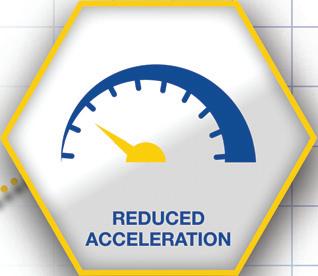

Offerings
Comline’s range of wheel bearing kits aim to deliver a no-hassle, high-quality option for workshops. Production of its kit is governed by strict tolerances, with facilities operating to ISO 9001 certified standards and in compliance with TÜV regulations.

Lightweight, high-carbon steel for a robust, heat resistant and long-lasting service life, combined with stringent and extensive inhouse testing, claiming to ensure technicians can be assured of a simple and quality fit. In short, Comline wheel bearing kits are premium quality products delivered to market with the promise of a competitive edge.

Wheel bearings play a pivotal role in mobilising all vehicle types; therefore, technicians require the support of a supplier that offers a wide-ranging portfolio – the company has a range of 600 that spans across European, Japanese and Korean applications.
Depending on the required application, technicians will note that wheel bearings stretch from generation to generation: from the single row ball ‘gen 0’ options, to more complex, dual flange with double row ball ‘gen 3’ variants that are typically found in more contemporary vehicles.
WATCH!
To help spread the word about the symptoms of a failing wheel bearing, the company has produced a short clip that it hopes workshops can utilise to educate the market. To watch, simply scan the QR code.
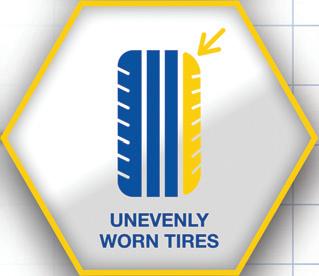


WANT TO KNOW MORE? FOR MORE INFORMATION WWW.RDR.LINK/AAW020 TYRES, WHEELS & ALIGNMENT 46 APRIL 2023 PMM
Possible symptoms of a front or rear wheel bearing beginning to fail

EV does it!
With some predicting that 80 per cent of passenger cars on our roads could be EVs by 2050, EV fluids will soon become mainstream in the aftermarket space. Castrol’s own EV fluid range currently consists of Castrol ON EV transmission fluids, thermal fluids, and greases.

While ON EV Thermal Fluids and ON EV Greases are currently only available to OEMs, Castrol ON EV Transmission Fluid is already available to franchised and independent workshops certified to work on EV powertrains. Available in five-litre packs, the two new products – in D1 and D2 variants – suit a wide range of EVs, helping to extend the life of the drivetrain system and enabling EVs to go further on a single charge (vs. mass-market EV factory fill fluids). The product is a high performance and highly efficient fully synthetic fluid for transmissions paired with dry e-motors, offering high levels of gear and bearing protection.

Protection and efficiency
Advanced EV Transmission Fluids deliver enhanced protection of the drivetrain and improves efficiency. Castrol EV Thermal Fluids help keep batteries cooler, even in extreme conditions, and this enables ultra-fast charging, while its EV Greases play a vital role in maintaining optimum efficiency and extending the life of vehicle components.
Patrick Bauer, senior technologist: “As greater volumes of electric vehicles enter the aftermarket, more OEMs have asked us to make an advanced EV transmission fluid available to their workshop partners to support ongoing repair and maintenance activity. While these fluids in some EVs are deemed as suitable for the lifespan of the vehicle, workshops still need to replace the fluids in the event of a repair, and there can also be a requirement to change the product early to safeguard protection in certain use cases. We have collaborated very closely with OEMs and Tier One suppliers to develop, test and deploy products to meet the required
performance criteria.”
In June 2022, Castrol and bp pulse launched a new study: Switching ON the rEVolution: The road to EV readiness for markets, carmakers and consumers. The study found that in 2015, on average, just 11 per cent of R&D spend was focused on fully electric vehicles, but this has almost doubled to 21 per cent today. Automotive executives anticipate it will reach 31 per cent by 2025, almost a three-fold increase over 10 years. If hybrid vehicles are also considered, by 2025 over 70 per cent of R&D spend will be focused on EVs and hybrids according to those surveyed2.
HYBRID & ELECTRIC VEHICLES
48 APRIL 2023 PMM
Premium lubricant specialist Castrol is working closely with car makers and motorsport teams to develop its latest range of EV fluids.
Consumers are also switching mindsets, with 53 per cent now considering an EV for their next vehicle purchase. Amongst those who have already made the switch, 99 per cent would consider an EV for their next vehicle purchase.
According to the research, the biggest barrier slowing the industry’s transition to electric vehicles is the high cost of batteries, with 56 per cent of automotive executives citing this as a concern. The next most significant barriers were found to be the availability of charging infrastructure (43 per cent) and a lack of tech talent (40 per cent).

The launch of Castrol ON products is aligned with the company’s PATH360 strategy, which aims to help deliver a more sustainable future by saving waste, reducing carbon and improving lives. Castrol is investing in and developing products that support the world’s transition to renewable energy and the wider adoption of e-mobility.
Castrol aims to be a net zero brand by 2050 or sooner, and Castrol’s ON EV fluids are a step in this journey, with the products having been certified carbon neutral.
New lubricant for motorcycles

Castrol claims its new Act>evo 4T provides continuous protection for motorcycle engines, fighting build-up of deposits, maximising engine cleanliness and offering corrosion protection. The lubricant is suitable for all four-stroke motorcycle engines where API SL (and below) and/or JASO MA2 specifications are recommended.

The new product features ‘Actibond’ molecules that, in the company’s words, “cling to an engine’s internal components” to provide continuous protection across all stages of the ride – when starting up, when running, and even when the engine is off.
The new formulation is supposed to provide 50 per cent better wear protection for bike
engines during start-up, fights the build-up of deposits to maximise engine cleanliness during operation and offers corrosion protection.
Samit Mehrotra, global brand director at Castrol, comments: “A new addition to our existing portfolio of motorcycle lubricants, Act>evo is the result of detailed in-house and industry testing to develop a product that meets exacting performance criteria and ensures superior engine protection.”
WANT TO KNOW MORE? FOR MORE INFORMATION WWW.RDR.LINK/AAW021
KNOW YOUR PARTS
Heat exchangers specified for Renault and Nissan electric motors
UFI has been chosen to supply the heat exchanger for the new ePT-160 front electric motor, 160kW, mounted on the new Renault Megane E-Tech and Nissan Ariya. The e-motor will also equip other C-segment model vehicles that will be launched by 2024 within the Franco Japanese alliance and, according to UFI, has the potential to become very popular in Europe in the next few years.
How does it work?
The heat exchanger for the ePT-160 is of an aluminium plate type and produced according to vacuum brazing technology that allows for a robust and clean product. The UFI heat exchanger is made up of four layers dedicated to oil and four to coolant. The oil enters through the base plate fixed directly on the outside of the electric motor. The heat exchanger configuration has diagonal counter-flows. It means that the liquids (oil and coolant) flow in opposite directions; oil and coolant cross their path into alternating layers. For the 4x4 version available on the Nissan Ariya e-4ORCE 4WD, UFI supplies an additional heat exchanger for the rear electric motor. Also made of aluminium and featuring vacuum brazing technology, it has seven layers for oil and six for coolant. The

“The UFI heat exchanger is made up of four layers dedicated to oil and four to coolant.”

WANT
KNOW MORE? FOR MORE INFORMATION
HYBRID & ELECTRIC VEHICLES 50 APRIL 2023 PMM
TO
oil and coolant liquid enter through the base plate fixed directly on the outside of the electric motor. The heat exchanger configuration has parallel counter-flows. The two liquids flow in opposite directions but remain on the same side of the plates layer. UFI Filters Group CEO, Rinaldo Facchini, said: “The collaboration with the Renault-Nissan-Mitsubishi Alliance represents a milestone for UFI Filters. It testifies that theUFI Filters Group is a technology leader in the area of electric mobility. Being present on an electric motor that goes from 120,000 pieces a year –aiming to reach 300,000 – shows that thermal management of battery-powered vehicles is one of the company’s strengths.” WWW.RDR.LINK/AAW022
UFI Filters has confirmed it is providing OE heat exchangers for Renault-Nissan-Mitsubishi Alliance’s electric motors.

TEST and CHARGE
Most of a vehicle’s vital organs are thoroughly checked during a routine service, but we keep seeing evidence that the battery, the beating heart, is frequently neglected. Rotronics investigates how adding battery checks to a routine service could bring revenue to your workshop.

It seems illogical to check every inch of a vehicle and not the battery. The brake pads, the tyres and the exhaust may be in perfect condition, but the car won’t leave the forecourt or get off the drive for very long if the battery fails. We asked Ken Clark from Rotronics for advice to readers, to help demonstrate how including regular battery test and charge checks will make any workshop more professional and profitable.
Speaking from experience
Ken can talk from personal experience about the importance of routine battery testing and charging. His own family vehicle’s battery was left in very poor condition following a workshop visit for an inspection due to flashing warning lights. After the inspection, his vehicle was up and running again but the battery was at a very low voltage because the engine had been running for four hours in repair.
Ken Clark, managing director at Rotronics, explained: “After several hours of
tests, I received all the results in a report that included a fantastic video. I was told in the video about the condition of every corner of the vehicle. Except for one essential piece of information: the health of the battery –which was not talked about once in the report.
“When I got back to Rotronics HQ, the vehicle was tested and charged with the Midtronics DCA8000 and I discovered that the battery was significantly discharged. If I hadn’t known what to do and been alert to the battery issues, the battery would have failed speedily. So, it wouldn’t matter that everything else on the car was working, I would have needed roadside recovery.”
Ken has provided a simple guide for technicians to avoid this situation for their own customers. To make sure that your customers’ batteries are not in a worse state when they leave your workshop, add the following to your own workshop service and repair processes:
THE MODERN WORKSHOP
52 APRIL 2023 PMM
■ Make it mandatory to test and charge all vehicles.
■ Charge for Charging: that means that every vehicle that comes into your workshop should have a battery test and charge according to the results.
■ You can do the maths on charging £5-£10 per test and charge.
■ It takes under a minute to test a battery.
■ Don’t miss out on replacement revenue opportunities for batteries that are at the end of their lives.
■ If the battery is going to fail anyway, it’s better that you provide a replacement in your workshop setting than the customer sitting at the side of the road.
Such a big deal?
Just how extensive is this issue of ignoring the battery? Ken and the team surveyed visitors to Mechanex 2022 and discovered that just under 60 per cent say that they test every vehicle, meaning over 40 per cent are ignored. Those batteries are at risk of being defective and the technicians have missed a golden opportunity to sell a new battery. However, when probed further, 74 per cent admitted they would only use a battery charger if the vehicle would not start, so Ken feels that the 60 per cent number is optimistic.
online dashboard and reporting system from battery data that has been collected from national/regional workshops. This works in conjunction with the EXP1000FHD.
Through analysing 12-months’ 2022 ROBIS data, covering five independent, single-site workshops, the Rotronics team could see that of the tests conducted, only 24 per cent of the vehicles had batteries that could be considered “good”. 37 per cent of the batteries needed to be “charged” and 39 per cent needed to be “replaced”.
Three quarters of all batteries tested needed attention and would have caused the customer to have a roadside breakdown if not charged or replaced.

Recouping the costs
The Rotronics team, armed with data, have been working with a number of nationwide, multi-site workshops, to help get them on board with charging appropriately after a test.
Ken Clark says: “We keep discovering large site workshops who will battery test, to tick a process box, but then won’t charge
appropriately. They may as well not bother because it’s the appropriate charging that really makes the difference to the long-term health of a battery.
“We recommend using the DCA8000 for appropriate testing and charging because it’s a plug-in-and-leave option which will show you what the test recommended and how the battery has been charged –without you lifting a finger. The results can be printed out or emailed to your customers, so that you have a foolproof method of validation.”

In a time when the cost of living is top of everybody’s mind and workshop budgets are being fiercely protected, Charge for Charging makes real sense, when it is coupled with providing excellent customer service. It could also give you a tangible point of difference to other workshops in the eyes of your customers.
WANT TO KNOW MORE? FOR MORE INFORMATION
WWW.RDR.LINK/AAW023
PMM APRIL 2023 53
“If the battery is going to fail anyway, it’s better that you provide a replacement in your workshop setting than the customer sitting at the side of the road.”

Do you speak ‘DOUBLE CLUTCH’ ?
Schaeffler has added three new dates to its ever-expanding double clutch training calendar.
Kicking off at the Tool Connection training centre in Southam on 26th and 27th April, the IMI-approved two-day course addresses the design, operation and repair of both the dry and wet clutch systems for all popular Volkswagen Group DSG gearbox applications. It is designed to encourage and empower professional technicians and workshop owners to confidently take on semi-automatic double clutch servicing and repair jobs without the need to send them to a specialist.
The second course takes place at Coleg Sir Gar in Pibwrlwyd, Wales on 6th and 7th June, and the third back at Tool Connection in Southam in November. Two further events and venues are in the pipeline for later in the year.
“Although the main purpose of the training course is to give technicians the knowledge and confidence to undertake VAG double clutch system replacements using our LuK 2CT repair solutions,” explains Schaeffler technical services manager, Alistair Mason, “it also allows us to explain the many other ways in which Schaeffler and the REPXPERT platform can help them work more efficiently.
“The two days follow the same format,
Schaeffler LuK has announced a series of IMI-approved double clutch system training courses to ensure workshops keep up-todate with changing technology.
with day one covering dry clutch systems and day two covering wet. Each day starts with an overview of the double clutch system, followed by the theory behind the clutch and mechatronics. We then move on to a practical removal and installation before looking into the common issues that can affect the three main elements: gearbox, mechatronics and clutch.”

The training, which includes lunch and refreshments on both days plus IMI certification, costs £349 + VAT per person.
Training partnership extended Schaeffler and Bilstein have offered joint technical training on chassis systems for several years, extending this partnership by collaborating on the REPXPERT garage portal.The range of content has been

continuously developed to now include product information, fitting hints and tips, practical advice and vehicle-specific installation instructions. Examples include advice on calibrating advanced driver assistance systems (ADAS) after suspension work, explaining how to adjust the groove on the shock absorber, and how to diagnose and eliminate annoying suspension noises.
The partnership combines Schaeffler’s chassis system know-how with Bilstein’s suspension expertise in shock absorbers and springs. “Garages today are dealing with increasingly complex servicing and repairs, so there is a great need for well-prepared information and practical tips. We are therefore delighted to offer, in partnership with Bilstein, a solution to provide this content to workshops throughout Europe,” says Sven Olev Müller, Head of Schaeffler REPXPERT.
“So far, our content on shock absorbers, springs and so on has been very well received, and this success has led us to provide our knowledge on all aspects of the chassis system via REPXPERT” said Rainer Popiol, Head of the Bilstein Academy.
WANT TO KNOW MORE?
FOR MORE INFORMATION
WWW.RDR.LINK/AAW024
PMM APRIL 2023 55
THE MODERN WORKSHOP

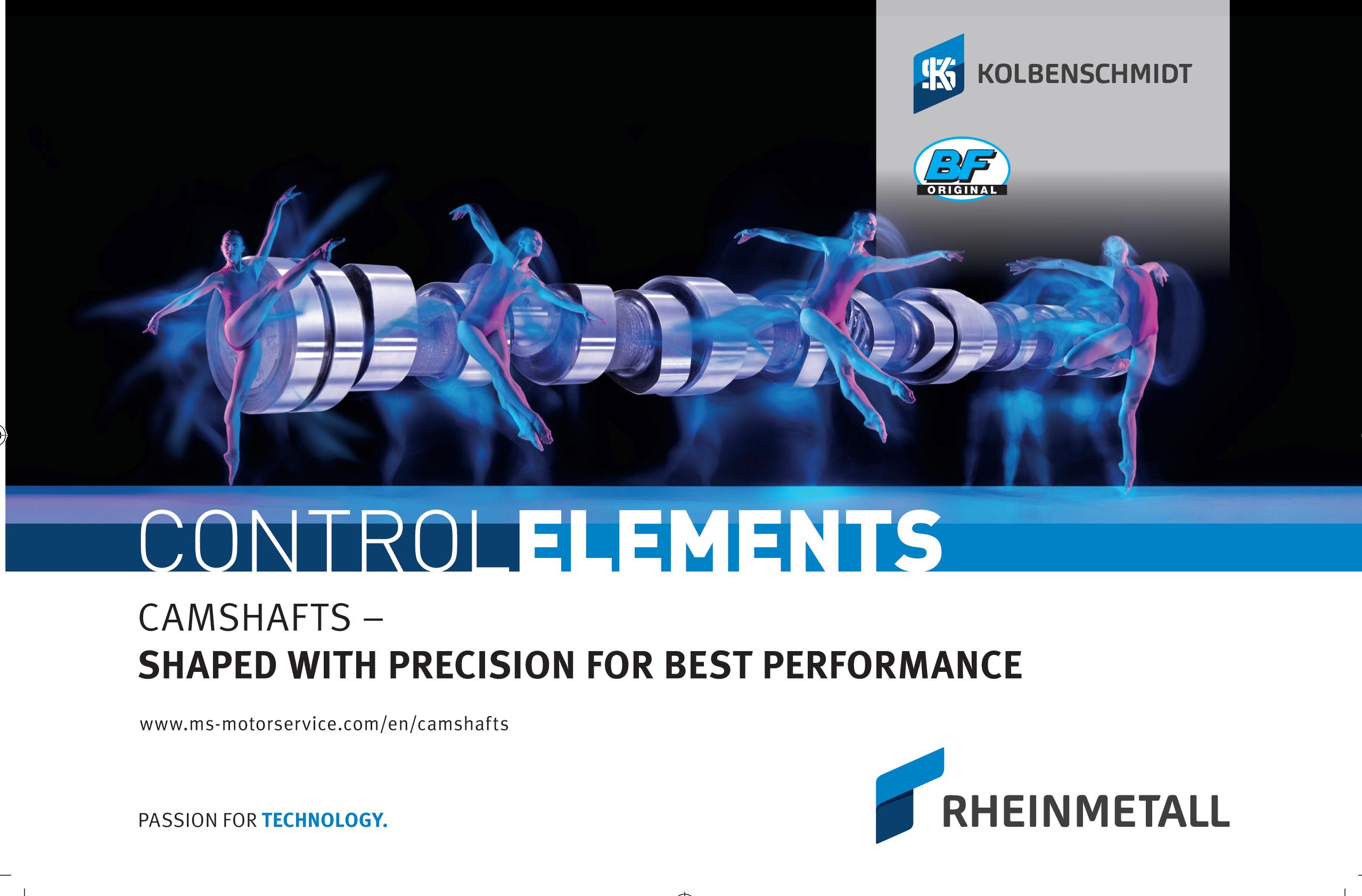
MAKE A PITSTOP
WITH
LIFE ON THE RACETRACK WITH LUCAS OIL-SPONSORED DRIVER TONY LYNCH


As rallycross drivers we are only allowed up to four mechanics in the paddock, but sometimes we need the mechanics back at base to help to get us out of trouble.
It’s the penultimate racing weekend of the season and the team is challenging strongly for the championship. We are racing at Scotland’s Knockhill circuit. It’s day one of two back-to-back rounds. The Landsail Team Geriatric Toyota MR2 has won heat one but everything changes when halfway through heat two, I’ve got an engine fire. A broken fuel pipe that caused it can be fixed, but the drive belts, pulleys and wiring loom are among the major component casualties.
It looks like our season is over. I speak to our team of support mechanics back home, who agree that good performances on day two could restore our championship challenge. They decide to cancel all plans for a quiet weekend and immediately begin cannibalising the wiring loom on the spare car! It’s 240 miles away in northwest England. It’s 2pm. We put the race car on the trailer and head south. The race team shares
the driving and the breaks during the five-hour haul.
We arrive back at base at 7pm to find that the home team has removed the wiring loom. We need to be back on the road by 3am to make the starting grid. We swap in the new loom, replace the brake pipe, restore the drive system and test and it’s 2am. Shortly after 7am, we take showers in the hotel rooms we didn’t use. Breakfast will be on the hoof.
Sunday, heat one: The Toyota is showing no ill-effects. In fact, I’m lapping more quickly than before. Both sets of mechanics have done wonderful jobs! We win the first heat, put more points on the board in the second and win the third. It’s looking good for the final run-off and I feel like I am on a roll.
The car gets quickly away from the grid, but the Knockhill track is living up to its reputation for unpredictable surfaces. I get caught out by one of the notorious bumps on the loose surface section of the circuit. This unsettles the MR2 and sends it into a roll and out of the race and there’s extensive damage but — thanks to the safety gear — I am relatively unscathed apart from a deep feeling of culpability.
After two five-hour drives, with two teams of mechanics working through the night, our championship chances look to be over. What an emotional rollercoaster of a weekend.
CONNECTIONS QUIZ





Try and figure out what connects each of the answers!
1. Colby, Bri and Edam are all types of what?
2. What is the name of the US band formed by Debbie Harry and Chris Stein in 1974?
3. The sculpture David by Michaelangelo is made of what material?
4. Who was queen of Great Britain and Ireland between 1837 and 1901?
5. What does Bugs Bunny famously love eating?
6. Which utensil is used to channel liquids or fine-grained substances into containers with a small opening?


7. Starbucks, Costa and Pret A Manger all sell what drink deriving from beans?
8. Which popular sweet treat comes from cocoa beans?
9. Which cooking measure is the equivalent of 8 imperial ounces?
10. What connects all of these answers?
Answers: 1.Cheese 2.Blondie 3.Marble 4.Victoria 5.Carrots 6.Funnel 7.Coffee 8.Chocolate 9.Cup 10.Cakes
Oily business
As listeners to the podcast will know, the PMM team were up to Lincoln recently to chat with Witham Group’s managing director Nigel Bottom. During our lovely chat, Nigel revealed his thoughts on all things oils – from their manufacture to their price. According to Nigel, it’s unlikely the price of oils will be returning to pre-Ukraine levels – a big disappointment. However, as Nigel rightly pointed out, the price of an oil change is a tiny fraction compared to the cost of the vehicle and it makes it a lot more efficient. It’s not such a tiny proportion if you’re driving Editor Kieran’s little old Polo, of course…

Exhausting work
PMM and sister magazine PMF (Professional Motor Factor) often go around on joint visits, such as our recent trip to BM Catalysts’ manufacturing plant and warehouse to find out how the experts research and manufacture each catalytic converter. Here is PMF editor Tom Henman talking to BM Cats’ commercial director Mark Blinston

MOT Madness
It’s all anyone’s been talking about around here lately and PMM ’s twitter followers have made their opinions known to the government: Hands off our MOT!
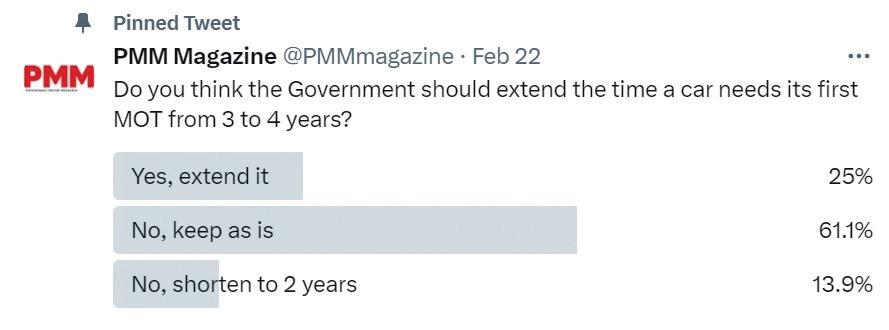
Out and About withPMM
What has the PMM team been up to recently?
Call a doctor!
This game takes us all over the place and an interesting example was the Banstead Make Ready Centre, where the full fleet of NHS vehicles for the South East are taken care of and, well, made ready. It was great to meet the team and have a cuppa!
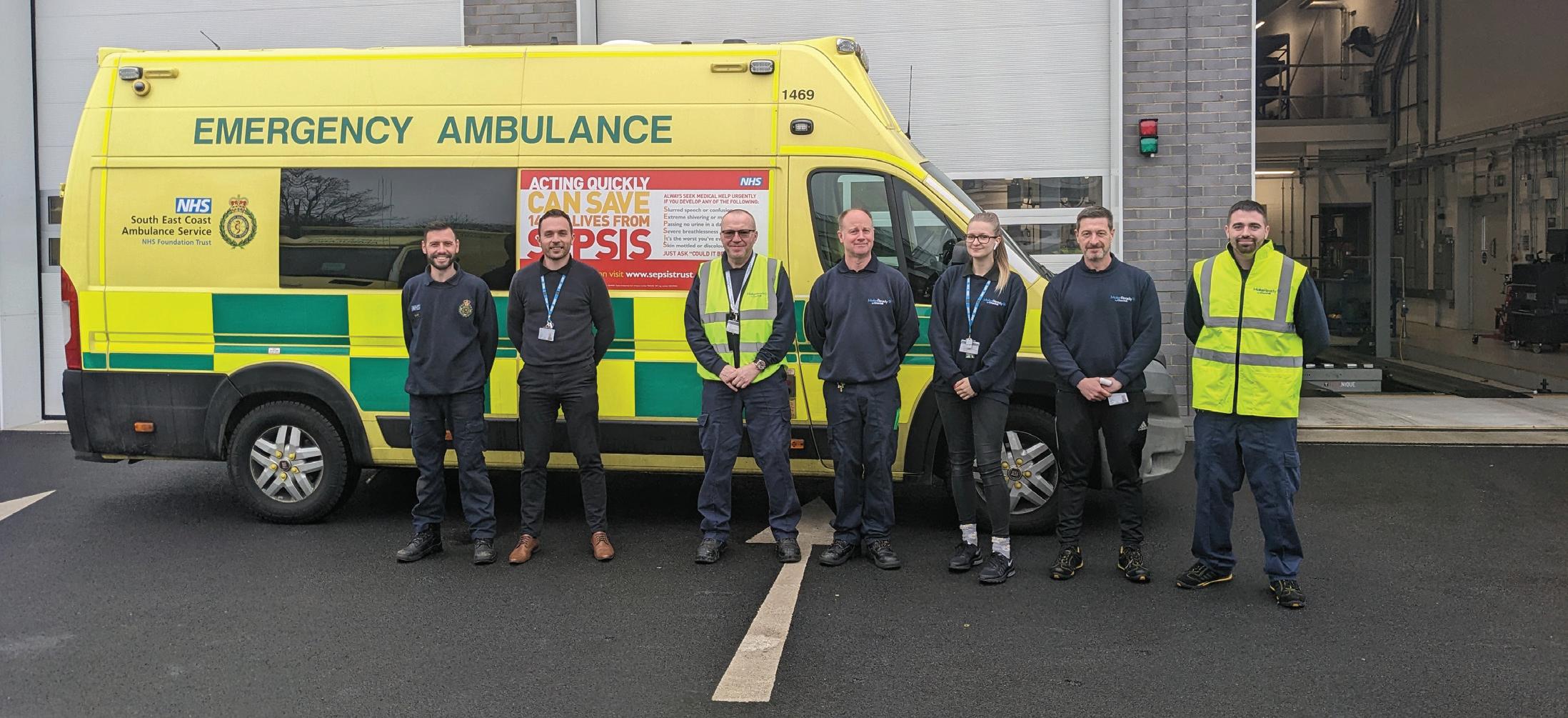
58 APRIL 2023 PMM
OUT AND ABOUT



Digital Digest!

The








internet’s top






Those of you not taking advantage of the PMM website are truly missing out. With an array of technical articles, breaking news and helpful business tips, it’s a great source of information right at your fingertips. If you haven’t already, the PMM website is also a great place to listen to our monthly podcast (WWW.RDR.LINK/AAW026), If you’re not already convinced, this month, PMM ’s news and products editor, Freya Coleman, takes a look back at the most popular articles on the website from the past month.

5






from the 6th of February, have been made over a range of areas including hoe the MOT is administered. Make sure to follow the link below to stay up to date on the latest MOT news.
WWW.RDR.LINK/AAW027
Bedding brakes
Up next is an article from Juratek informing PMM readers about the importance of bedding brakes as the brake pad is half the friction couple, with the brake disc being the other half. How these two parts work together influences the NVH, proving the importance of bedding your brakes for safety and quietness.


WWW.RDR.LINK/AAW029
Diagnostics
In this next popular article, PMM ’s diagnostics expert Andy Howart explores why a customer’s 1.6 petrol Ford Focus is intermittently starting. He follows many steps to get to the bottom of this, including starting with a test drive before truly getting into it by taking a look inside and finding the car in poor state. This included a clogged air filter, split hose crank and a PCV valve. To find out the solution Andy came to, follow the link below.

WWW.RDR.LINK/AAW030
2

Timing belt teeth
Various diesel engines are prone to the teeth on timing belts being damaged, and Continental are here to explain why in this next article. Inside, the company stresses the importance of correct installation, locating the locking points on the camshaft sprocket which can be difficult on used pumps.
WWW.RDR.LINK/AAW028
3 4 5 1
MOT changes
MOT is the word on everyone’s lips, and this is reflected in this month’s top articles from the PMM website. Thus, kicking off this month’s most popular articles in an update from the GEA about updates on the MOT testing manuals and special notices released by the DVSA. These changes, in place






MOT fraud
In this final MOT themed popular article this month, the DVSA’s Caroline Hicks outlines the lengths the organisation is going through to prevent MOT fraud following 700 tested being disqualified in the past two years. These measures include prosecuting and banning testers and garage managers from the MOT, mystery shopper exercises, and surveillance operations.
WWW.RDR.LINK/AAW031

PMM APRIL 2023 61
ONLINE ROUND UP
PRODUCT SPOTLIGHT
Bartec’s TPMS sensor
PMM takes a closer look at the Bluetooth TPMS sensor from Bartec: the rite-sensor blue.
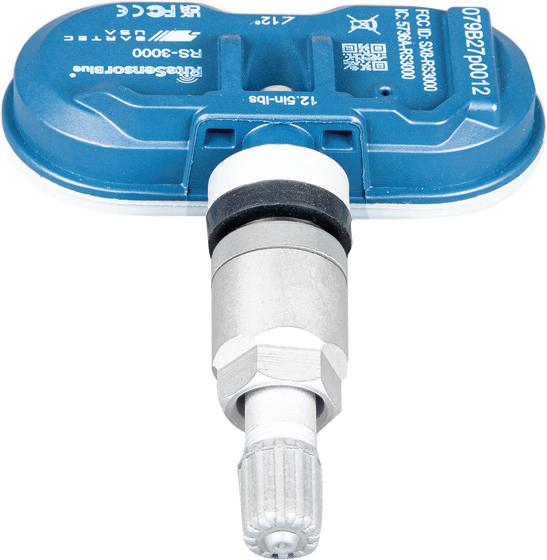


Simple testing
Rite-sensor blue is the latest tool from Bartec designed to satisfy an emerging need in TPMS service. A Bluetooth TPMS replacement sensor, for EVs like Tesla, the product is said to be fast and easy to use. Simply test for a faulty sensor with a Bartec TPMS tool, install the rite-sensor blue and then drive the vehicle. The resulting repair saves both time and money for the technician and customer.
Suitable for...
This new TMPS sensor is suitable for Tesla Models S, 3, X and Y, right out of the box. The TPMS tools TECH600 and TECH450 activate and decode the OE fitted sensor to diagnose a fault such as low battery in the sensor, making vehicle diagnosis accurate and fast. If one of the OE sensors fail due to low battery, then there is a chance that the other sensors on the car will also fail having experienced the same duty cycle. The tools will diagnose this for the technician and enable the repair of multiple sensors in one visit if required.
Colours available
Keeping up with demand the ritesensor blue has two stem options to meet the various wheel colours. These options are aluminium and black.
What they’re saying...
“The rite-sensor blue and the associated tool diagnostics are the latest example of how Bartec are out in front of the TPMS market with solutions. Tesla led the way with this technology, but several other OEs are planning to fit Bluetooth sensors and we look forward to supporting our tyre shop and repair shop customers with effective tools and sensors ahead of the market.”
WANT TO KNOW MORE? FOR MORE INFORMATION
WWW.RDR.LINK/AAW032
62 APRIL 2023 PMM PRODUCT SPOTLIGHT
Mythbusters
Sorting out fact from fiction in the workshop
WHAT YOU’VE HEARD:
EV servicing, whilst it will still happen, will bring in less revenue for independent workshops.
WHAT WE’VE HEARD:
Unfortunately, it does appear that EV servicing will generate less revenue for workshops. According to recent data from BookMyGarage.com workshops are charging an average of £103 to service EVs, as opposed to £151 for petrol engines and £163 for diesels.
Overall average garage bills (including MOTs, servicing, and repairs) are up to 43 per cent less for EVs compared to other fuel types. A key reason for lower EV servicing costs is that there are fewer moving parts and therefore less work is required during a typical service compared to ICE vehicles.
Jessica Potts, head of marketing at BookMyGarage.com, said, “The nature of EV powertrains not requiring engine oil changes, fuel filters, air filters or spark plugs means that servicing an electric vehicle requires less labour and fewer replacement parts and fluids, helping to lower costs for motorists.
“That said, servicing is still essential for EVs from a safety perspective, so the throughput of vehicles in workshops and the business opportunity for garages should remain similar to ICE vehicles – much of the cost saving is from fewer replacement parts rather than a reduction in labour.”
WHAT WE SAY: GET IN TOUCH
Whilst EVs will generate less revenue in servicing, it is still important to remember that they need to be serviced as often as ICE vehicles and with less work to do on each vehicle, may actually work out well for garages who find they have extra man hours for other jobs. Another silver lining is that whilst full EVs are cheaper to service, hybrids are actually more expensive that petrol engines, so all is not lost!
Heard something interesting in the workshop (or even the pub) lately and wonder how much truth is in it? Give us a shout and we’ll do our best to sort out the fact from the fiction.
Email us at pmm@hamerville.co.uk

■ ENGINE LUBRICANT
Castrol has launched an engine lubricant for motorcycles, Act>evo, that is said to offer continuous high-quality protection for bike engines. The new product features actibond molecules that cling to an engine’s internal components to provide continuous protection across all stages of the ride –when starting up, when running, and even when the engine is off. The new formulation claims to provide 50 per cent better wear protection for bike engines during start-up, fights the build-up of deposits to maximise engine cleanliness during operation and offers excellent corrosion protection, even when the engine is off.
Castrol Act>evo 4T 10W-40 is available in 4L and 60L pack sizes and is suitable for all four-stroke motorcycle engines where API SL (and below) and / or JASO MA2 specifications are recommended. Castrol Act>evo 4T 20W-50 is also available in a 60L pack size and is suitable for all four-stroke motorcycle engines where API SL; JASO MA2 specifications are recommended.

WWW.RDR.LINK/AAW033
■ GLUE PULLING DENT REMOVAL KIT

Glue pulling is an ideal repair process when there is restricted access behind the dent to be repaired and when used with care the paintwork will not be damaged. This kit from Power-TEC (part number 92395) uses a pneumatic dent puller (powered from the workshop air line) and is supplied with ten assorted glue pads, including circular and split elliptical versions suitable for a variety of different dent shapes and sizes.

The pressure of the pneumatic puller can be adjusted to suit the size and depth of the dent and the speed of the pull. The length of the draw can also be adjusted to suit the size of the glue pad and the depth of the dent. The pull can be steady and slow or for more stubborn dents the slide hammer action can be used to steadily tap the dent out. With a shallow dent sometimes just one steady pull will remove it while a deeper dent may require two or three applications of the glue pad.
WWW.RDR.LINK/AAW034
■ TYRE SEALANT
Autogem has introduced Gemseal to the aftermarket to provide workshops with the very same solution as dealerships at a cost-effective price. With over 55 per cent of new vehicles coming with tyre sealant which eventually expires, Autogem identified that there would be a demand for the product, not least when many vehicles are sold second-hand with the compressor or the sealant removed.
Gemseal is compatible with all tyres from 14” to 20” and is a nontoxic and non-corrosive product approved by the largest automotive manufacturers in the world. It is said to be a direct replacement for the Original Equipment solution supplied with many new cars today and easily washes out of the tyre to allow for full repair, assuming that the puncture injury is within the repairable area of the tyre tread.

WWW.RDR.LINK/AAW035
■ MAGNETIC E-CLIP HOLDER
As you know, installing an E or C-type can be fiddly and awkward sometimes especially if access is difficult. The Laser Tools E-clip installation tool (part number 8438) is designed to hold the clip securely for you while you place it is position and push it into place.
Suitable for use with for ‘E’ and ‘C’ type clips, it includes magnetic clip holder together with an ergonomic handle which features a pound-through design allowing for the end of the tool to be struck with a small hammer to help push the clip into position on the shaft. The compact design allows better access options on difficult to reach clip grooves.
WWW.RDR.LINK/AAW036
64 APRIL 2023 PMM WHAT’S NEW?
■ ENGINE TIMING TOOL KIT
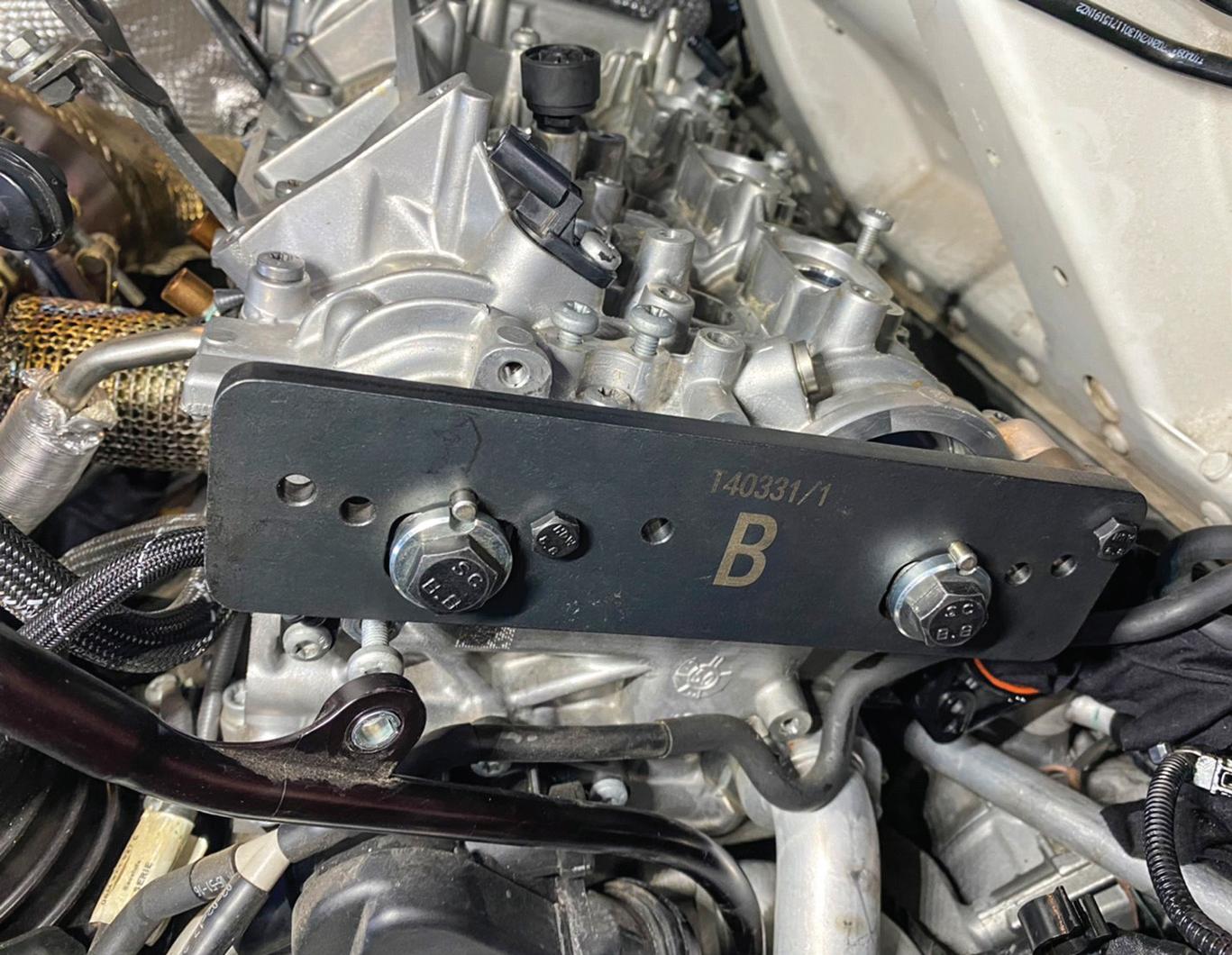
The latest addition to the Laser Tools range of industry-leading specialist tools is this engine timing tool kit (part number 8503) for the latest generation Audi 2.9 and 3.0 litre petrol engines. The kit is designed to lock the camshafts in the method approved by the manufacturer and is designed and engine timing tool kit manufactured by Laser Tools. This is a full and comprehensive kit — applications include: Audi A6 (2018 - 2021), A8 (2017 - 2021), Q8 (2019 - 2021), RS4 (2017 - 2021), RS5 (2017 - 2021), S4 (2017 - 2020), S5 (2016 - 2020), SQ5 (20172020) and RS4 (2017 - 2021). The applicable engine codes include: 3.0L CWGD, CZSA, CZSE, DCBD, DLZA and 2.9L DECA.
WWW.RDR.LINK/AAW037
■ INSPECTION LIGHT
The NightSearcher iSpector 750 is an inspection light with a cordless, heavy-duty design and a toughened optical lens. Featuring both bright work light with a wide flood beam and a powerful torch with a spot beam, it is said to be a versatile, dual-purpose LED light. This fast-charging type C inspection light has two power settings in work light mode, offering a 750 lumens output at full power. It also features a single torch/spotlight operation that runs for up to seven hours. It can be positioned pretty much anywhere, in any orientation thanks to its unique base, capable of both 360-degree rotation and up to 90-degree angle adjustment. Once orientated, the rechargeable LED inspection lamp can be held in place using its magnetic base, or integrated hanging hook.


WWW.RDR.LINK/AAW038
■ PIPE BENDER AND CLAMP SET

Need to make up a new section of brake pipe or accurately mirror the original pipe’s bends and curves when making up the new pipe? Reach for this brake pipe bender and clamp set from Laser Tools (part number 8523).
Included are a pair of brake pipe bender tools for shaping both copper and cupro-nickel brake pipes in situ on the vehicle, or on the bench. They are designed to be used with a standard 6mm hex key or a 1/4"D ratchet. Two pairs of brake pipe clamps are also included, to enable the new pipe to be held securely next to the existing pipe, so that the new pipe can be shaped to replicate the one that it’s replacing. With the existing and new pipes clamped together, the bender tool is steadily turned, the tool’s radius ensuring a smooth curve without any kinking or flattening of the new pipe.
WWW.RDR.LINK/AAW039
PMM APRIL 2023 65
Here is a useful summary of all the adverts that appear in this issue of Professional Motor Mechanic



Each is listed with its page number and a direct URL that will get you straight to the relevant online information
Kalimex Ltd ......................................................................(page 49) www.rdr.link/AAW113
MAHA UK ........................................................................(page 23) www.rdr.link/AAW114
Maverick Diagnostics ........................................................(page 33) www.rdr.link/AAW115
MS Motor Service ..............................................................(page 56) www.rdr.link/AAW116
Nissens ..............................................................................(page 56) www.rdr.link/AAW117
PMM Podcast ....................................................................(page 26) www.rdr.link/AAW118
Ltd ..................................................................(page 29) www.rdr.link/AAW112
PMM Online
60) www.rdr.link/AAW119
RDR
49) www.rdr.link/AAW120
RMIF ..................................................................................(page 51) www.rdr.link/AAW121
Robert Bosch Ltd ................................................................(page 4) www.rdr.link/AAW122
Saxon Brands ....................................................................(page 59) www.rdr.link/AAW123
Schaeffler Automotive ..................................................(page 2/IFC) www.rdr.link/AAW124
Straightset ..........................................................................(page 39) www.rdr.link/AAW125
KEEP UP TO DATE WITH PMM ADVERTISEMENT INDEX A FOLLOW US ON TWITTER @PMMMAGAZINE B LIKE US ON FACEBOOK @PROFESSIONALMOTORMECHANIC VISIT OUR WEBSITE WWW.PMMONLINE.CO.UK Arnott Europe ....................................................................(page 63) www.rdr.link/AAW100 Ben Ad ........................................................................(page 67/IBC) www.rdr.link/AAW101 BG Automotive ....................................................................(page 6) www.rdr.link/AAW102 Borgwarner Technologies/Delphi ..............................(page 68/OBC) www.rdr.link/AAW103 Contitech Power Transmission ..........................................(page 45) www.rdr.link/AAW104 Dayco Europe ....................................................................(page 47) www.rdr.link/AAW105 Diagnostic Connections ......................................................(page 37) www.rdr.link/AAW106 Driv ....................................................................................(page 40) www.rdr.link/AAW107 Ferdinand Bilstein UK Ltd ................................................(page 11) www.rdr.link/AAW108 Garage Equipment Association ..........................................(page 13) www.rdr.link/AAW109 Hella ..................................................................................(page 54) www.rdr.link/AAW110 Induction International ......................................................(page 59) www.rdr.link/AAW111 Jack Sealey
......................................................................(page
..................................................................................(page
Quality without compromise

Eicher brake pads and discs are exclusively manufactured in quality-controlled production facilities. We use carefully selected materials and formulations to meet the performance and comfort standards of leading vehicle manufacturers.

All Eicher’s brake pads and discs meet the “parts of matching quality” requirements in the BER EEC Commission Regulation 461/2010 (Block Exemption certified) so they won’t invalidate vehicle warranties, and conform to ECE R90, the European standard for brake performance and safety – so you can fit Eicher with total confidence.

The Eicher brake friction range includes over 1,000 part numbers, providing coverage of 97% of the UK vehicle parc.

• Over 260 quality control checks completed for brake pads
• Bolts & accessories included with the pads where applicable
• 100% Copper free pads – strong green credentials
• Alternative to OE without compromising on quality
• Nationwide stock – local availability across UK and ROI.
your local branch now!
Call
* Our braking warranty is no quibble. It does not include off road use (4x4 days or track days). It does not cover alterations outside of the manufacturers specifications.






















 Editor KIERAN NEE
Editor KIERAN NEE
























































 FIG.2 This bonding strap connects the case of a high voltage component to the chassis on a Golf GTE
FIG.2 This bonding strap connects the case of a high voltage component to the chassis on a Golf GTE


























































 This is an opportunity for technicians and MOT testers of all ages and from anywhere in the UK to get their hands on the latest tools and products, get in front of the camera and provide cutting edge product reviews for the PMM YouTube channel.
This is an opportunity for technicians and MOT testers of all ages and from anywhere in the UK to get their hands on the latest tools and products, get in front of the camera and provide cutting edge product reviews for the PMM YouTube channel.













































































































